Tagged: bandai
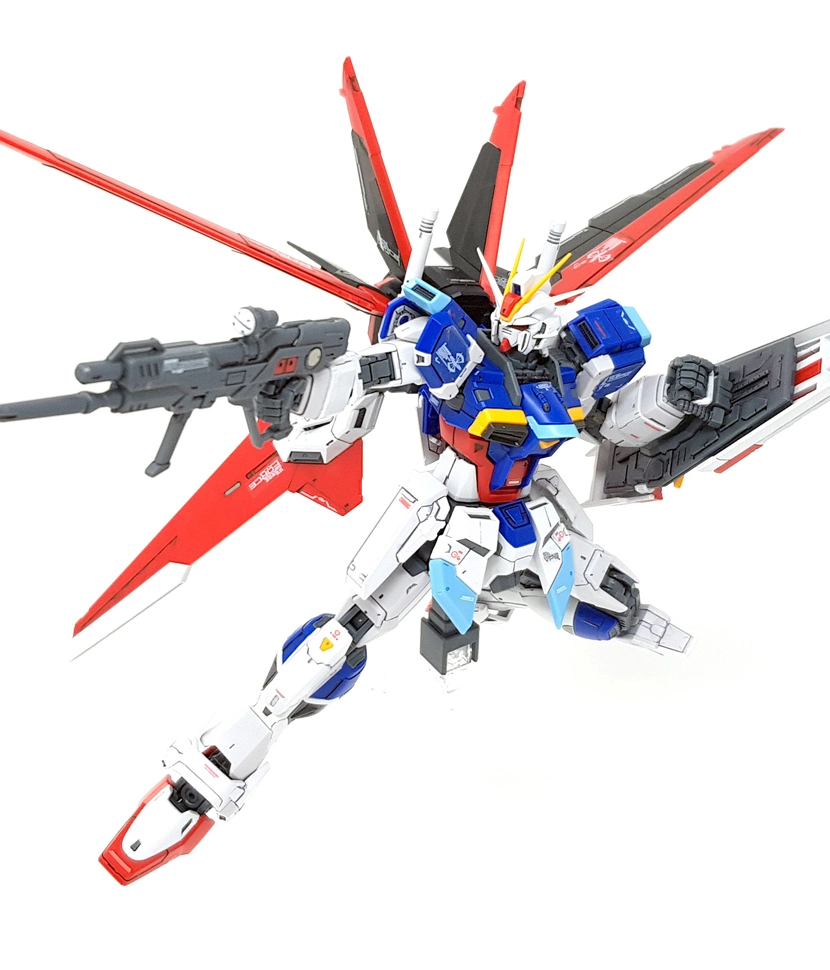
Real Grade Force Impulse Gundam
Full disclosure – the Force Impulse Gundam is a suit that I really don’t know the first thing about. Both of my regular readers will know that I generally don’t watch much Gundam anime and so I say this about a lot of kits, but with this one, I didn’t even know it existed until the RG came out, and I just bought it because I like Real Grades and I thought it looked cool.
I also reviewed this kit on Youtube, you can scroll to the bottom to check that out. Anyway, as usual, let’s start with a look at what’s in the box.
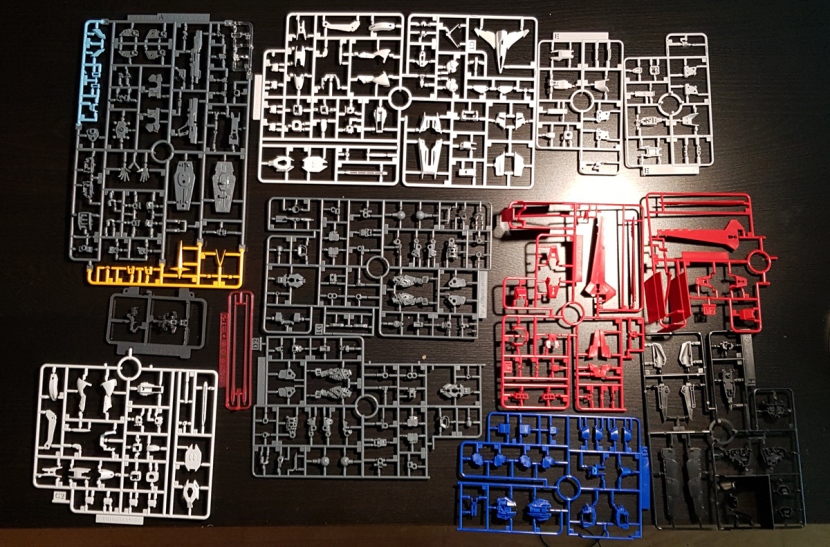 Notice, of course, the B sprue center left. There are exactly two parts here – one goes inside the Core Splendor and the other one inside the chest. Honestly, I’m not sure these are even necessary, at this point it feels like they’re just including them because it’s a Real Grade and it has to have them.
Notice, of course, the B sprue center left. There are exactly two parts here – one goes inside the Core Splendor and the other one inside the chest. Honestly, I’m not sure these are even necessary, at this point it feels like they’re just including them because it’s a Real Grade and it has to have them.
The build starts with the Core Splendor, which is what the core fighter’s called on this suit for some reason.
It does look rather splendid, though. Probably my favorite core fighter that I’ve built thus far. Too bad you’ll never get to see it again. More on that later.
The build continues with the chest, which is assembled in two main steps. first is this section, which is basically a few armor bits mounted on top of the aforementioned B part.
Then you continue with the shoulder joints, which are fairly complex because they’re needed for a transformation, as well as the bottom half of the armor, basically.
You then assemble the arms. Pretty standard stuff, but I will say it’s nice that the shoulder armor attaches directly to the top of the arms. This has been the case in the RG line for a while now, but the way the shoulder armor mounts on top of the arm attachment peg on the older kits is a pet peeve of mine that I’m going to need another few years of therapy to get over.
Next is the head. As you can see, I needed to paint the cameras because they’re clear plastic and the kit comes with stickers for them. I really don’t understand why they keep doing this. Other than that, though, I will say that it’s a very nice looking head and assembly is mostly painless. You know how that can be an issue on these RGs where the parts are half the size of a grain of sand.
With the head assembled, you’ve got an upper torso ready for transformification, but you need some accessories first.
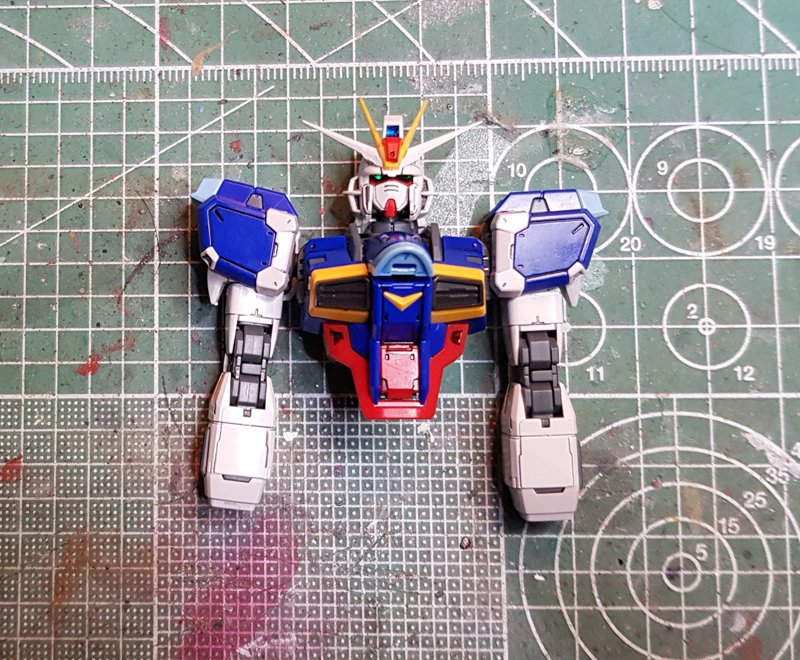
Namely the rifle…
…and the shield. This is a particularly nice shield, and it may or may not have been one of the reasons I bought this kit in the first place. What can I say, I’m a sucker for a good Gundam shield.
Now for that transformation. You basically dislocate the suit’s shoulders and twist the arms into position to turn it into what is apparently called the Chest Flyer. The only other step this involves is folding up an armor piece that covers up the face and ends up being basically invisible.
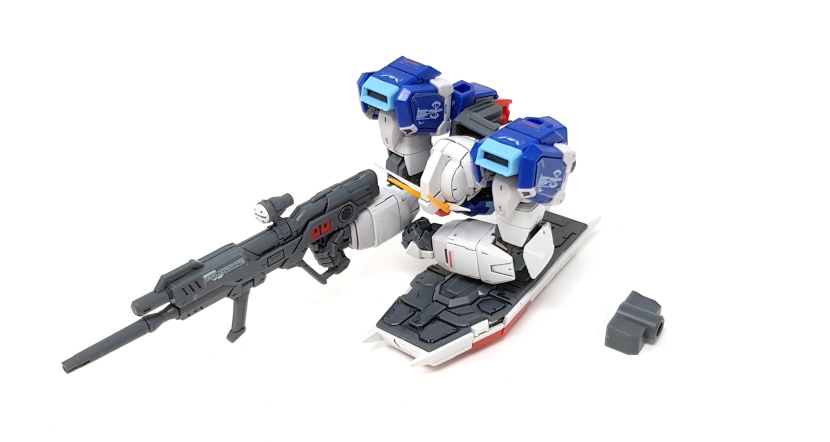
On the right here is an action base adapter in case you want to display it like this. I… do not. Let’s take a look at the legs.
Nothing terribly out of the ordinary here. The knees are actually needed for an even more ridiculous transformation than the Chest Flyer, but they look pretty much like the same double-jointed knees every RG has. I love the shapes and proportions of these legs, but it’s a bit of a shame that the upper thigh armor doesn’t move.
Assembly continues with the feet and the hip joints. Yes, you build the feet after the legs. What’s this world coming to? Before you know it, we’ll have dogs and cats living together.
We then proceed with the waist unit. Very standard stuff, as you can see. The side skirts open to store the Folding Razor knives. No silly German name for those, unfortunately.
Notice also the usual hinge part allowing you to lower the hip joints for extra mobility (not separately like on the Nu Gundam, unfortunately) and the bottom part of the upper torso that’s actually attached to the waist unit here because it’s where you insert the Core Splendor.
Once you’ve attached the legs to the waist unit, the whole thing transforms into this preposterous contraption called the Leg Flyer. This also comes with a fug-buttly action base adapter that you’ll see again when I complain about it below.
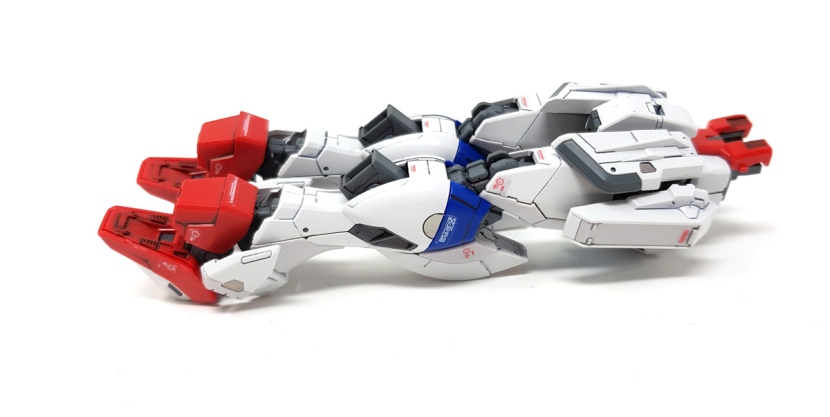
I didn’t transform that one knee properly, by the way. I don’t know how this happened, the knees are supposed to look like on the suit’s left leg.
The better news is how you attach the Core Splendor to all this. You open this little hatch…
…and then you insert the plane and fold it over to form the suit’s backpack. This is simple, it works well, and it actually looks good. It’s also kind of unfortunate, though, because it means the Core Splendor can’t be displayed separately unless you leave the main suit in its two “flyer” sections, which, um, you don’t want to do.
And that’s the Impulse Gundam complete.
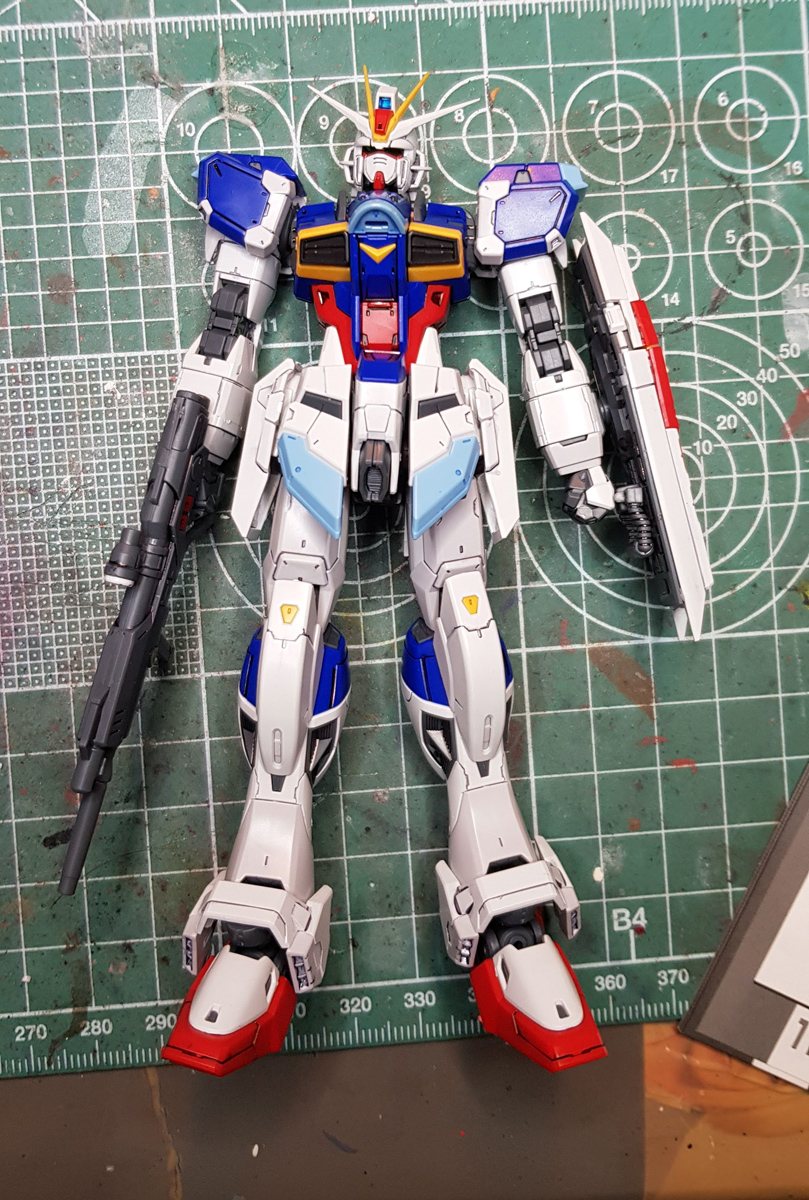
We’re not done yet, though. First we put together the Silhouette Flyer, which is really simple.
Next is the, ahem, Force Silhouette, which distinguishes itself from the Aile Striker by having an even more nonsensical name, and… not much else. But it looks cool. You start by assembling the main fuselage.
This is followed by the wings and the beam saber handles.
And finally these stabilizers that also have little thrusters on the side that fold out.
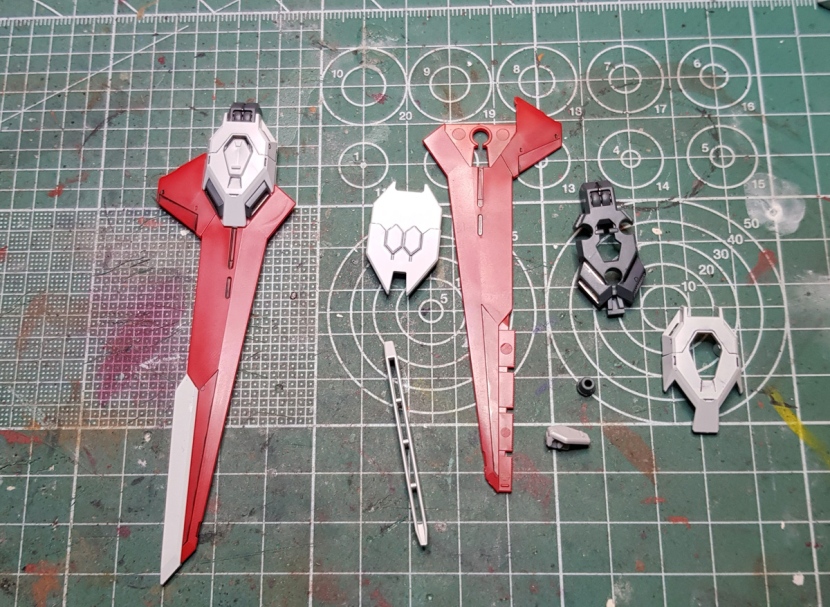
The not-Aile Striker can be combined with the not-Skygrasper to form this plane, and that’s the one “transformation” aspect of this kit that I will say looks really kickass.
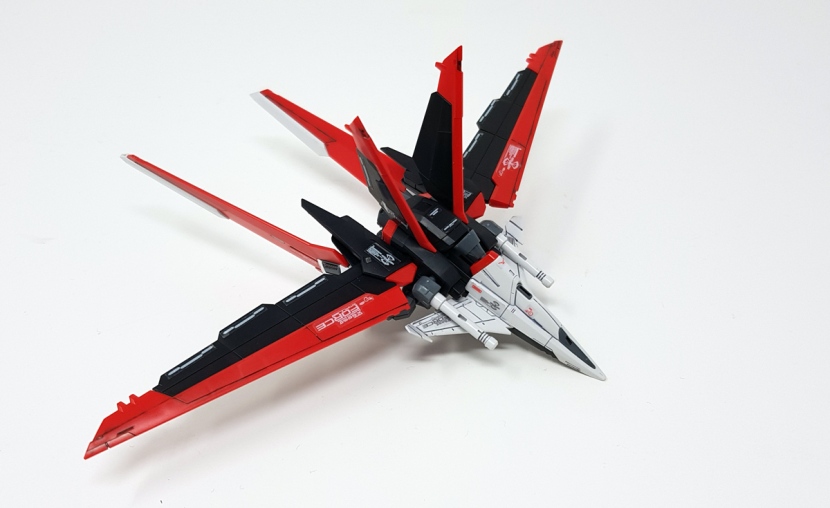
Oh yeah, and for some reason the very last thing the instructions have you assemble is the knives, so here’s an unnecessarily large picture of those.
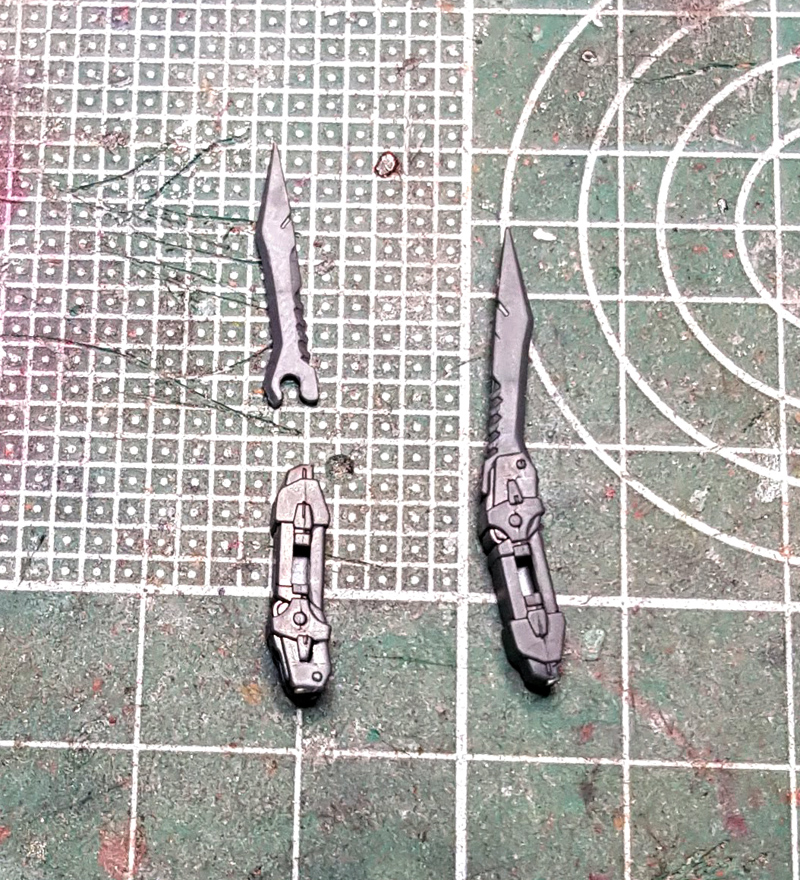
And that’s it. To be honest, I’m really not sure why, but this build felt a lot more involved than you’d think based on the pretty standard number of parts. Maybe it’s because there’s so much different stuff or maybe because it’s just… not terribly unusual or interesting, despite the transformation gimmicks.
Anyway, we’re done with the build, and you know what that means – here’s a look at the accessories.
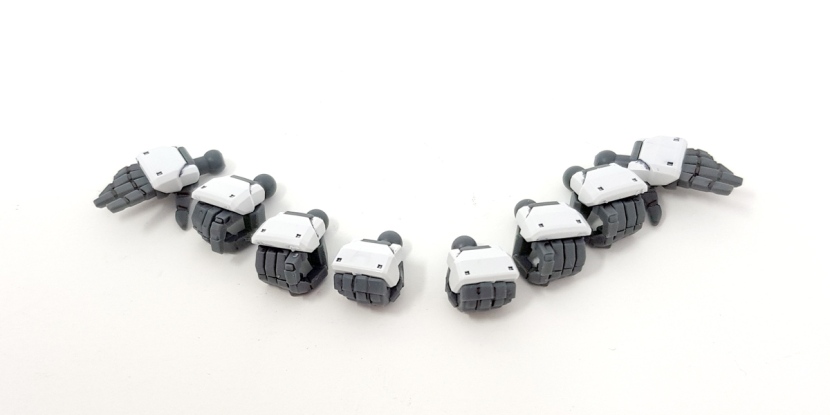
The hands are everything you need – two closed fists, two holding hands for the beam sabers, one trigger finger hand for the right and a holding hand for the shield on the left, and two open hands.
Here’s the rest of the accessories.
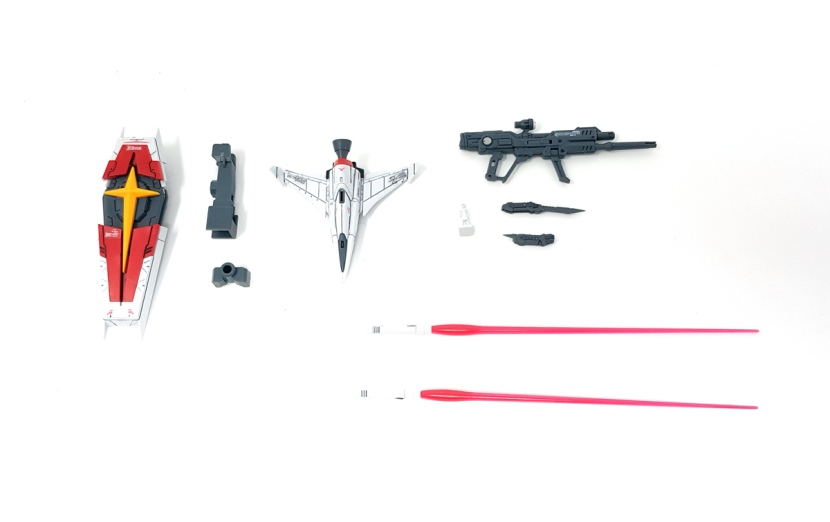
From left to right, we’ve got the shield, the two action base adapters, the Silhouette Flyer, the rifle, the knives, the pilot figure and two beam sabers.
Note the size of that action base adapter. This is the one I mentioned above – it has to be this big basically so that you can use it to mount the Leg Flyer on an action base, but the kit otherwise doesn’t come with a different one for mounting it in standard mode, which means you’ve always got this ugly contraption attached to the suit’s taint, like so.
I just really feel like if this was made from clear plastic or they had made a smaller alternate adapter, all of these pictures would look significantly better. The good news is that contrary to what you might think, you don’t actually need an action base.
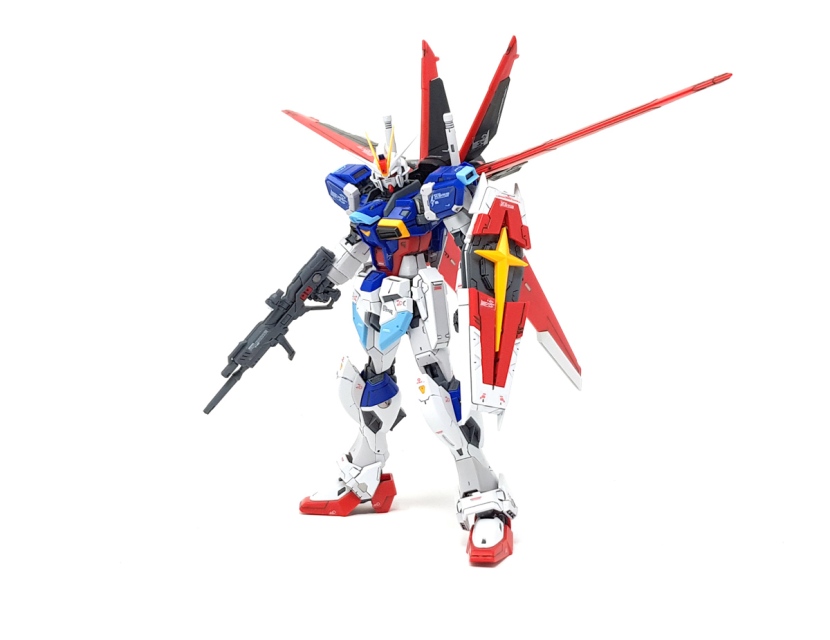
Yep, it actually stands up on its own, with the Force Silhouette attached, and without having to lean forward 45 degrees. I’m really not sure how that’s physically possible, but it’s true.
I’ve always thought these Rambo knives were silly, but I will grant that you can get some neat posing out of them.
I had by far the most fun with this, though, and looking at these pics again, I’m tempted to take the kit off the shelf and pose it this way instead of with the Force Silhouette attached.
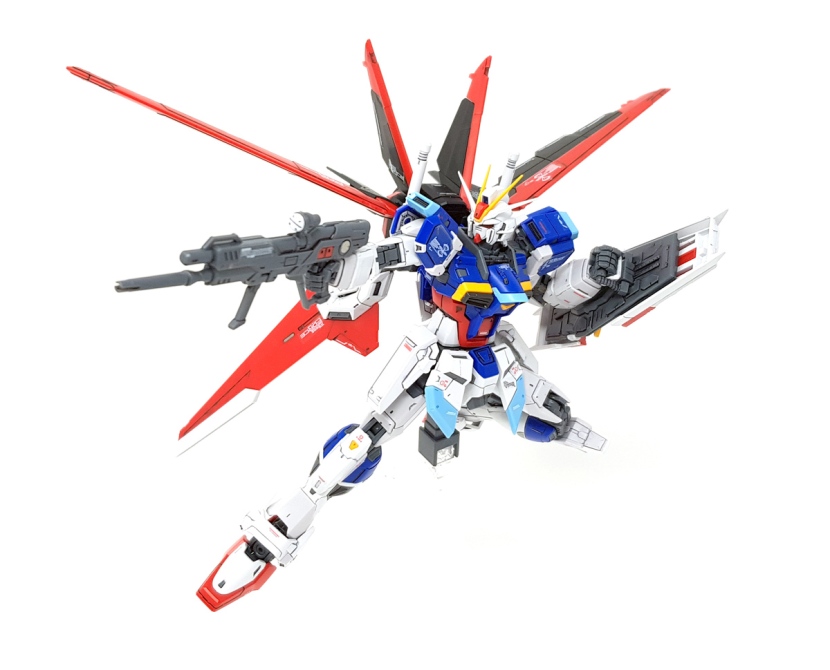
Although of course that looks good too.
Now do I recommend this kit? I’m gonna say if you’re a big fan of the Force Impulse Gundam, then yes, you should absolutely get this. Like all recent Real Grades, it’s incredibly well engineered, posable and stable. It’s really basically flawless – the only issue I had during the photoshoot was the upper torso occasionally popping off, otherwise it was really fun to work with.
At the same time, though, it just doesn’t do anything special. I’m guessing the idea was that it would be the first of the newer breed of RGs with a full-blown transformation and that’s what’s supposed to make it stand out, but frankly, the transformations are all kind of dumb, and while they don’t detract from the kit, they also don’t really add anything to it. It’s just another Real Grade, and unless you’re a fan of the design, you don’t really need this one.
Personally, I’m coming away from this build feeling a bit ambivalent about the whole thing. I certainly like the end result, but building this was kind of a chore. I used to build Real Grades because it was a throwback to years ago when I just enjoyed the simple fun of snapping together a complex kit without thinking about doing more than panel lines on it, but… I dunno, I think I may just not like that as much anymore as I thought. And I still don’t want to paint one of these because the tiny parts give me the willies.
So I don’t know what that means for the future. I still have quite a few unbuilt RGs lying around and that new Evangelion kit in the mail, so I’ll definitely have to do something with those, but I’m just not sure this thing is my thing anymore. Or maybe it’s just a phase, we’ll see. No doubt Bandai will release another engineering miracle next and I’ll have to get it.
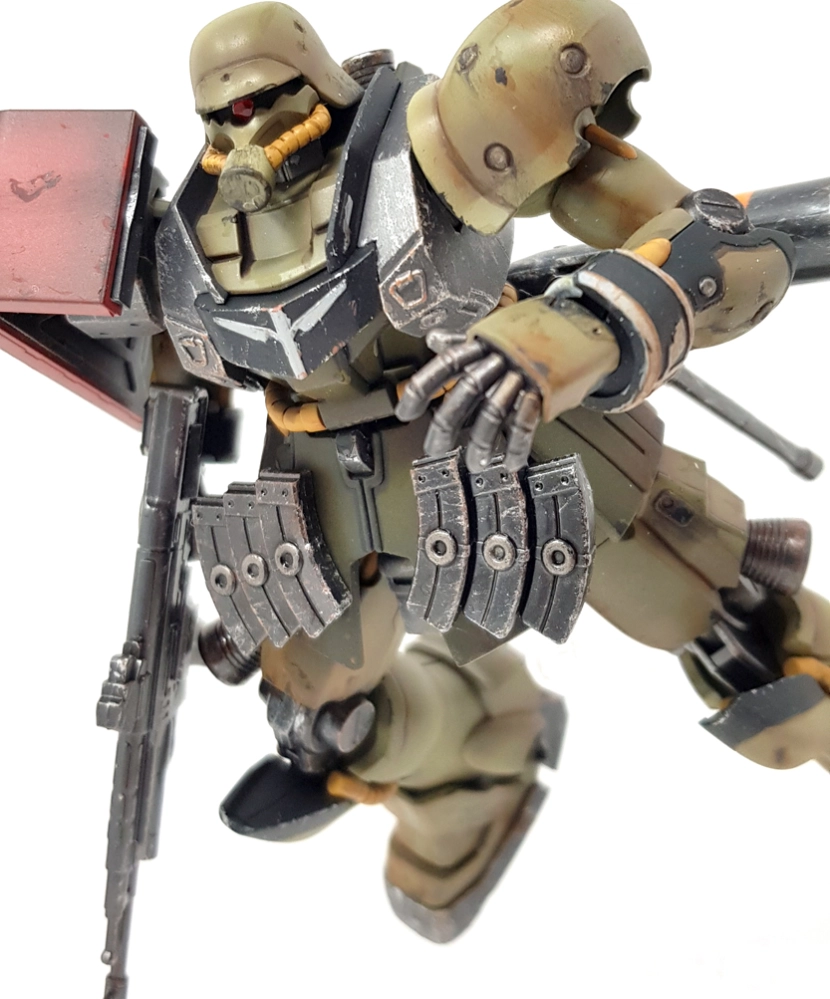
HGUC Geara Zulu
Somehow it’s been over a year since I did my last proper painted Gunpla build, and to be honest, I was feeling the ol’ Gunpla fatigue more than a little. I actually snapped this kit together a long time ago and originally had some plans to either modify it into a space Nazi robot or something Warhammer related, but then I badly needed to do a simple and straightforward project to get myself out of the usual spring funk, so I decided to just paint it up more or less straight.
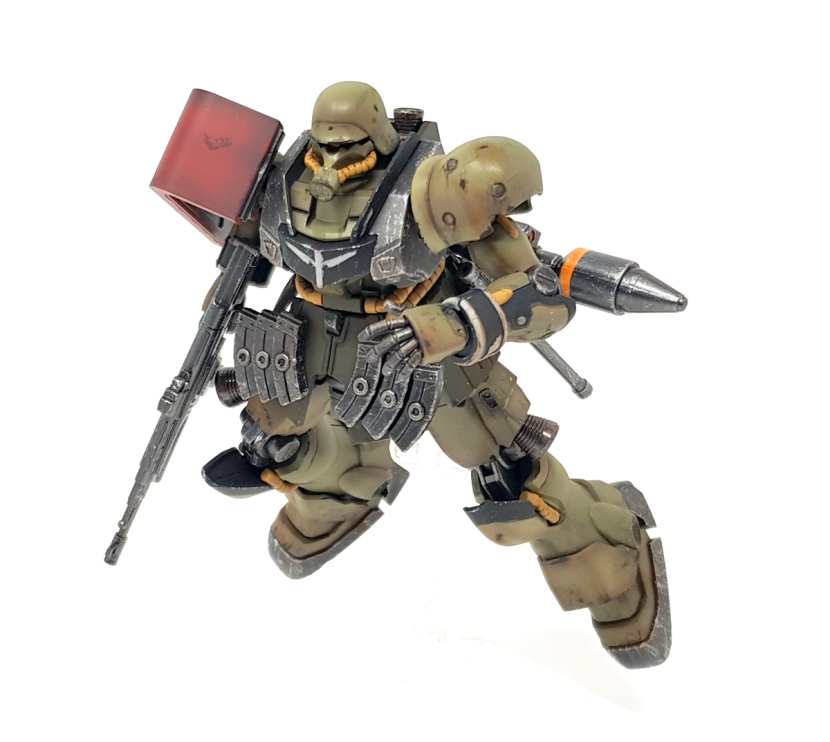
The base color scheme isn’t much different from the kit’s original colors – the dark green is Tamiya Olive Drab, the lighter green the same paint with white mixed in, and the mechanical parts and weapons are Vallejo Metal Color Gunmetal. What’s new here is that I did the preshading on the light green parts with Vallejo’s Burnt Umber, which I’ve used as a shadow color with green on miniatures before, and it worked really well here too. I also added some black trim, which mostly just reminded me that I hate masking.
The sleeves markings also didn’t work out as well as I had hoped. I’ve done this sort of thing simply by hand brushing on so many Warhammer minis at this point that I didn’t think it’d be a problem to just paint Mechanicus Standard Grey over the Nato black I’d used as a base, but Bandai’s trim is decidedly more shallow and it turned out to be a massive pain. A wash of Nuln Oil and some weathering hides most of the problems I had, but I’m not entirely satisfied.
For the shield, I couldn’t resist my usual impulse to paint it a different color to make it look like it had been replaced, so I used the same red/red brown combo I’d used on the Red Horn before and slapped a decal from the generic Unicorn waterslide sheet on it.
And finally, the tubes were painted Desert Yellow with a bit of Lemon Yellow mixed in to brighten up the color a bit.
After the gloss coat came the pin wash, and partly because Bandai plastic and white spirits don’t get along, I settled for water-based acrylic washes this time – Citadel Nuln Oil for the dark green and the gunmetal, and Agrax Earthshade for the green. This worked just fine and dandy. Purely for pin washes, I always find that water-based paints actually work quite well because the surface tension tends to make them pull into the recesses.
The first weathering step was chipping, which I did in two stages as before on the HMM Zillon. I used two different shades of green from Citadel for the first step, but truth be told, I really should have used something even lighter on the light green parts – the green chips are barely showing up. The problem here was that the gloss coat was almost too overpowering and I could barely see what I was doing. Stage two, as usual, was Tamiya Gunmetal on the lighter stuff and Chrome Silver on the darker parts, in this case just the black.
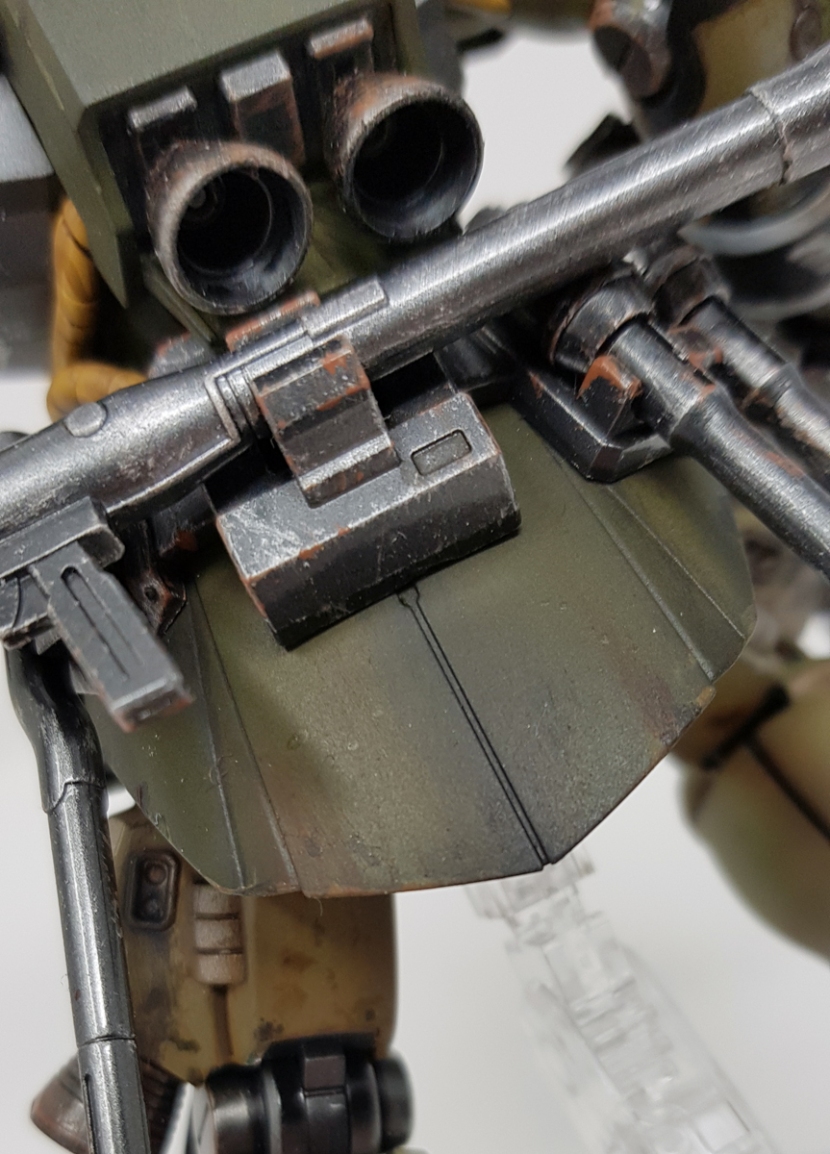
Next was streaking with Abteilung 502 Starship Filth and Dark Rust. I applied a tiny bit to the spots I wanted to have streaks running from with a toothpick, then basically drybrushed downward from there. This worked so well that I decided not to add further streaking on top with thinned-down paint, as I did on the S.A.F.S. before.
The weapons and all the other gunmetal parts got the usual treatment of a drybrush with Tamiya Chrome Silver and Gunze Rust, plus some added detail here and there with Leadbelcher. Decidedly nothing fancy, but this is honestly one of those things that work so well that I’d rather take the “don’t fix what ain’t broke” approach and just keep doing it. I also added that orange stripe to the bazooka because I have to have an orange stripe on everything. This was hand brushed on with Citadel Fire Dragon Bright, which was kind of a pain over the slick surface of the Vallejo metallic paint, but I figured the drybrushing and the topcoat would make it blend in, and… they did.
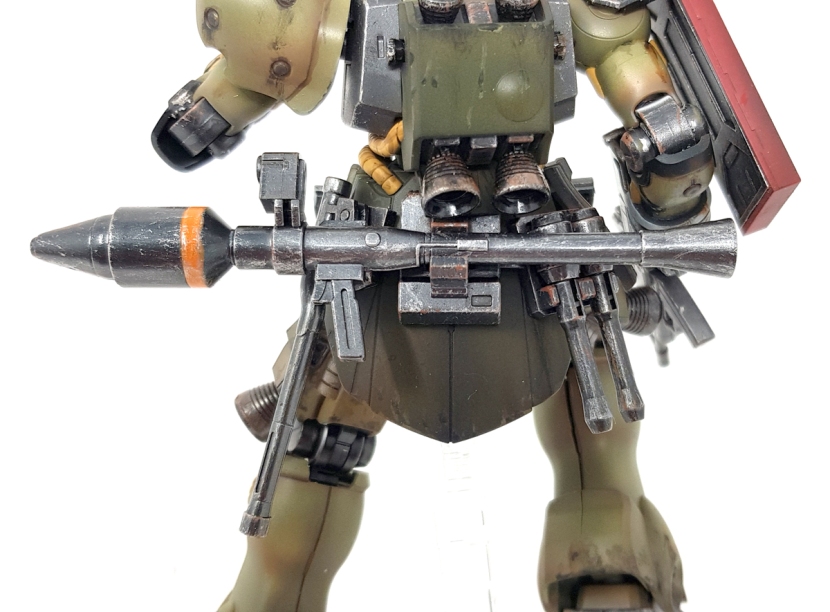
As usual, the final step was to paint the cameras with Vallejo Duraluminium, Tamiya Clear Red and my latest trick of dabbing some Citadel ‘Ardcoat on them for extra gloss. This mimicks the look of actual clear parts really well, and I’m particularly happy with how reflective the monoeye came out.
Well, and that was pretty much it, plus of course a Tamiya matt topcoat. I really didn’t do much of anything fancy with this one, but it was really fun to do, and I will say that closing up the seamlines on the legs and the round shoulder armor at least was not entirely new, but the first time I felt kind of comfortable doing that, and I think I can tackle models now that need seamline filling more badly.
I also came away from this one feeling like I need to do more HG kits – with a little love, they can look nearly as good as MGs, and they’re a lot of fun to work on because of the significantly lower parts count. There’s never a stage with these where it feels like you’re spending an entire week just basecoating inner frame parts.
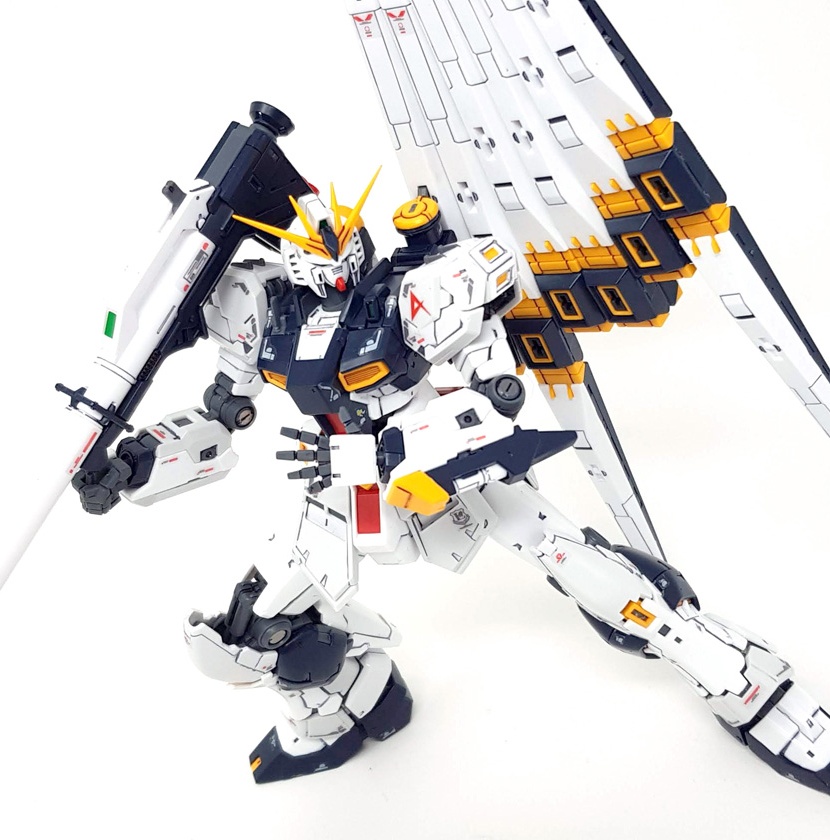
Real Grade Nu Gundam
Welp, it’s pretty much a given at this point that if there’s a new Real Grade, I’m going to do a snap build and review it. But honestly, I’m still only buying the ones I like. It’s just that I’ve liked all the ones that have been coming out lately.
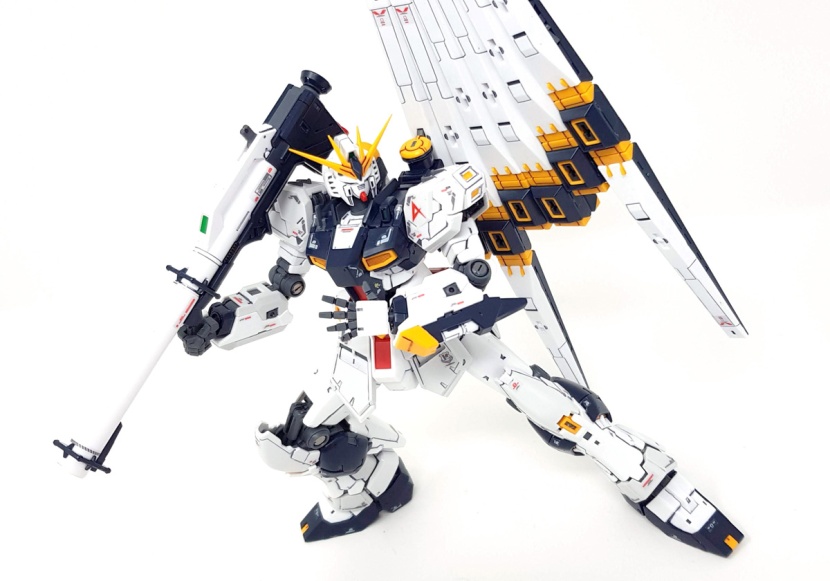
Now I’m afraid we’re going to have to start this review with a confession that I somehow forgot to take the usual “here’s what’s in the box” pic. I don’t know what happened, but you can check out my Youtube review if unboxings are what your plants crave. The short version is, it’s a big box, and there’s a lot of stuff in it, so we’re going to be here a while.
Stop me if you’ve heard this one before, but the build starts with the feet.
The assembly is a bit unusual because of that big spherical joint that you’d expect to see in the hips. Also, you may have noticed right here that there are no MS joint parts – taking a picture of the B sprue is another thing I forgot to do, but as you’ll see further down, the only MS joint parts on the entire kit go into the funnels, the suit itself has none of them at all.
Anyway, we continue the assembly with the legs. Here’s one of them and all the parts needed to construct the other.
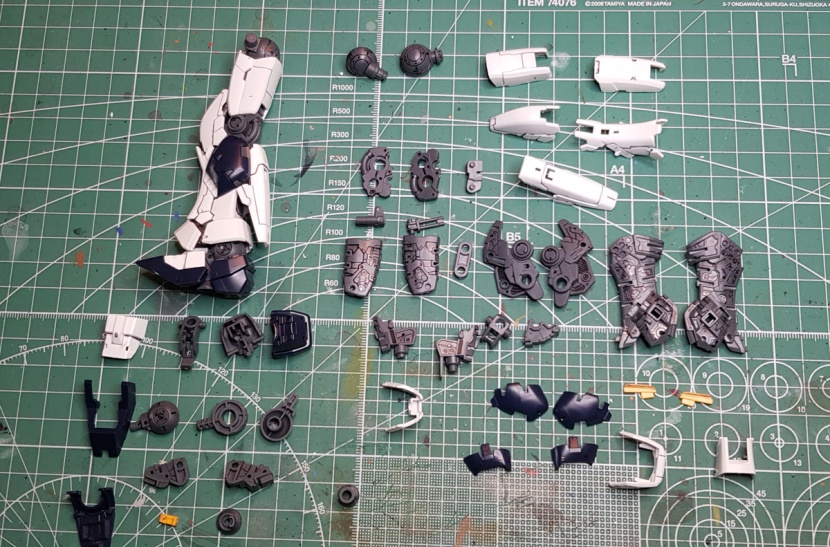 Yeah. That’s a lot of parts. Between that and the total absence of an MS frame, I think it’s fair to say we’ve officially crossed over into “Master Grade at 1/144th scale” territory now.
Yeah. That’s a lot of parts. Between that and the total absence of an MS frame, I think it’s fair to say we’ve officially crossed over into “Master Grade at 1/144th scale” territory now.
Assembly of the legs starts with the knee and then continues with the upper thigh. Notice the internal mechanism here. This is the sliding armor plates gimmick that’s been absent from RG kits since the Tallgeese because they apparently couldn’t make it happen without an MS joint frame. Well, it’s back.
The rest of the leg then goes together about as you’d expect, although there’s still quite a bit of moving stuff inside the inner frame because the ankle armor moves.
And then you add the armor. As you can see in the final pic, the upper thigh armor moves as you bend the knee, and the ankle armor can also move a bit.
Next is the waist unit. The interesting part here is that the hinged hip joints are separate, which means that you can actually unlock the legs separately, meaning you no longer have to dislocate both legs if you just need a bit more motion in one of them. Pretty nifty.
Otherwise the waist unit goes together, well, like a waist unit. It’s worth pointing out, though, that the way the skirts attach to the main unit is very simple, straightforward and therefore stable.
We continue with the torso which, as you can see here, is very flexible.
It loses some of that articulation once it’s all put together, but it’s still pretty impressive.
And of course the kit also has expanding shoulder joints for extra poseability.
The rest of the torso assembly is just adding the remaining armor pieces, which isn’t anything complicated or unusual.
The arms, as you can see below, are not identical. The left arm has this contraption that allows you to store a beam saber handle in it. This is actually a pretty nifty gimmick as the beam saber pops out when you slide the blue armor piece up.
Next is the shoulder armor, and we have a Headless Hessian.
The head is also not terribly complicated, but that’s ok. I’m still getting shivers everytime I think about what it was like to put the Crossbone Gundam‘s head together, so the simplicity and the reasonable parts size here were very welcome, and it still looks fantastic.
Assembly of the backpack starts, as is often the case, with the boosters.
Next you build the attachment point for the funnels. Or actually, you build two of these. The kit includes the second one that you attach the P-Bandai set with the other six funnels to.
And then we add the attachment point for the large beam saber, which can actually rotate to hide the hole the saber plugs into.
And finally, the funnels. These consist of quite a few parts because there’s a lot of nice color separation. Unfortunately, though, not all of them really fold all the way. That doesn’t get into the way of mounting them on the backpack at all, which works well – you can pick the kit up and shake it, and the funnels won’t come loose. But it’s still a bit OCD-inducing, if I’m honest.
Well, and that’s the Nu Gundam all put together sans stickers and weapons.
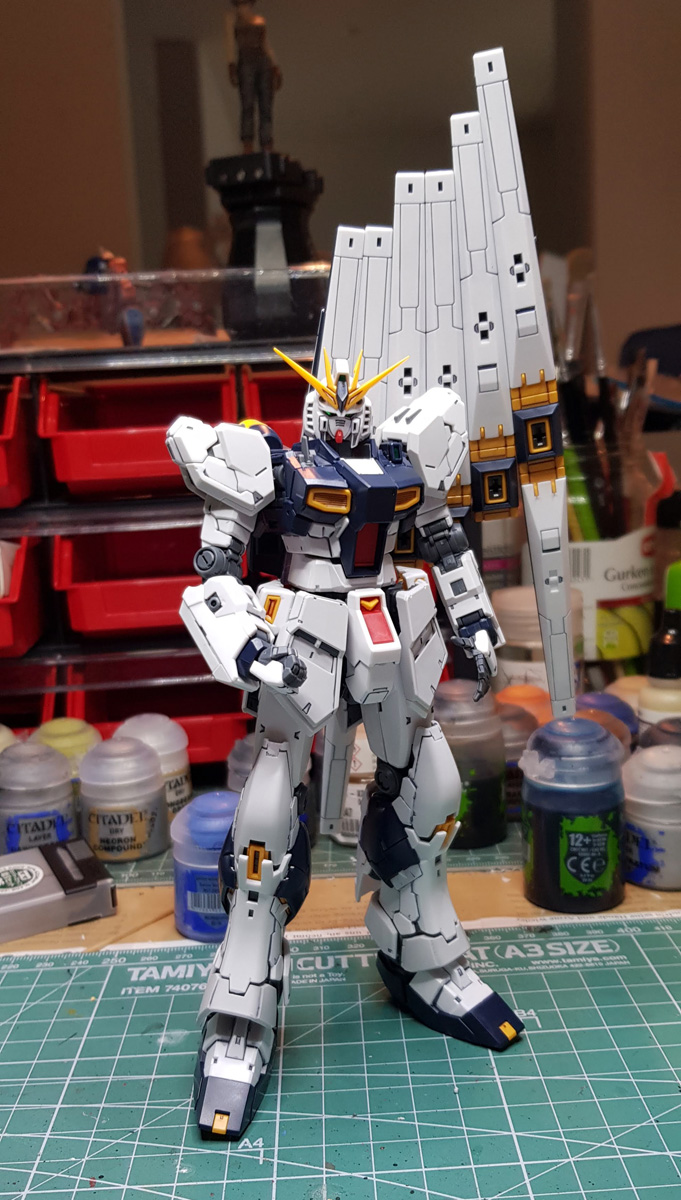 But hark, quoth I, what’s this you say? Accessories?
But hark, quoth I, what’s this you say? Accessories?
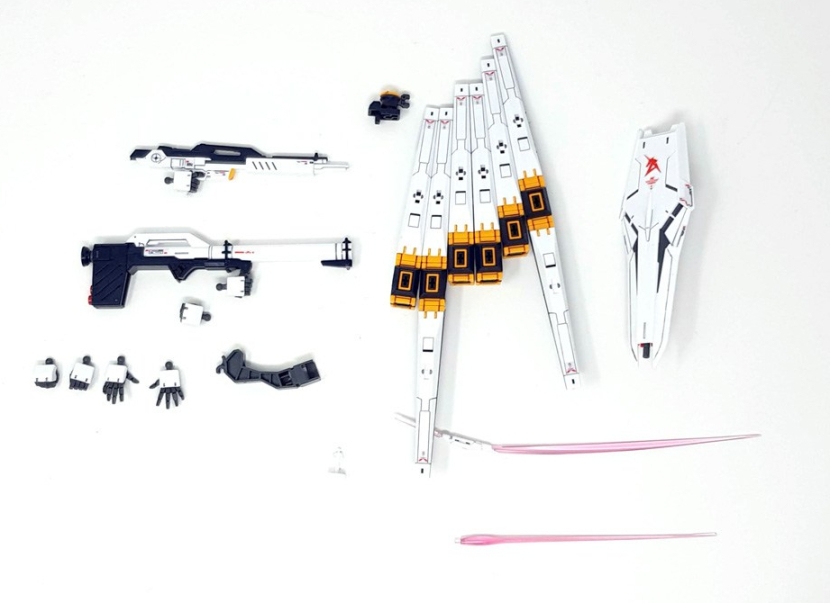
There actually aren’t that many, but what’s here is really solid. You get the beam rifle, the bazooka, the shield, a regular and the large beam saber, an array of open, closed and holding hands, a tiny Amuro and a really good action base adapter that plugs into the backpack. Also pictured is the extra attachment part for the funnels.
My only gripe with the accessories is that the shield doesn’t really clip onto the arm that well. It’s serviceable, but it also likes to fall off, and it ends up in a position where it’s hard to get any cool looking poses. I usually like to display my Gunpla with their shields, but with this one, it went back in the ziploc bag.
And speaking of posing and displaying and action base adapters, here’s the glamor shoot.
Also, to cap things off, I’ve got two size comparisons.
I think the pictures speak for themselves. The Nu is so big that it makes the Mk-II look like they’re not even the same scale. Like the Sazabi, it’s almost the size of a regular Master Grade.
If you can’t tell from the pictures, this is one of those kits that are just fun to play with because it’s so solid. Like all the more recent RG kits, the Nu marries excellent poseability with sturdiness and beautiful looks. I really feel like Bandai has found the sweet spot now where these kits are exactly as complex as they need to be, without any over-engineered or flimsy parts, and so they’re not only just as beautiful as the Real Grades have always been, but also rock-solid and really fun to build because everything goes together easily. The Sazabi is still my favorite Real Grade, but it’s really close. And I can’t wait to see what’s next for this crazy line of little engineering marvels.
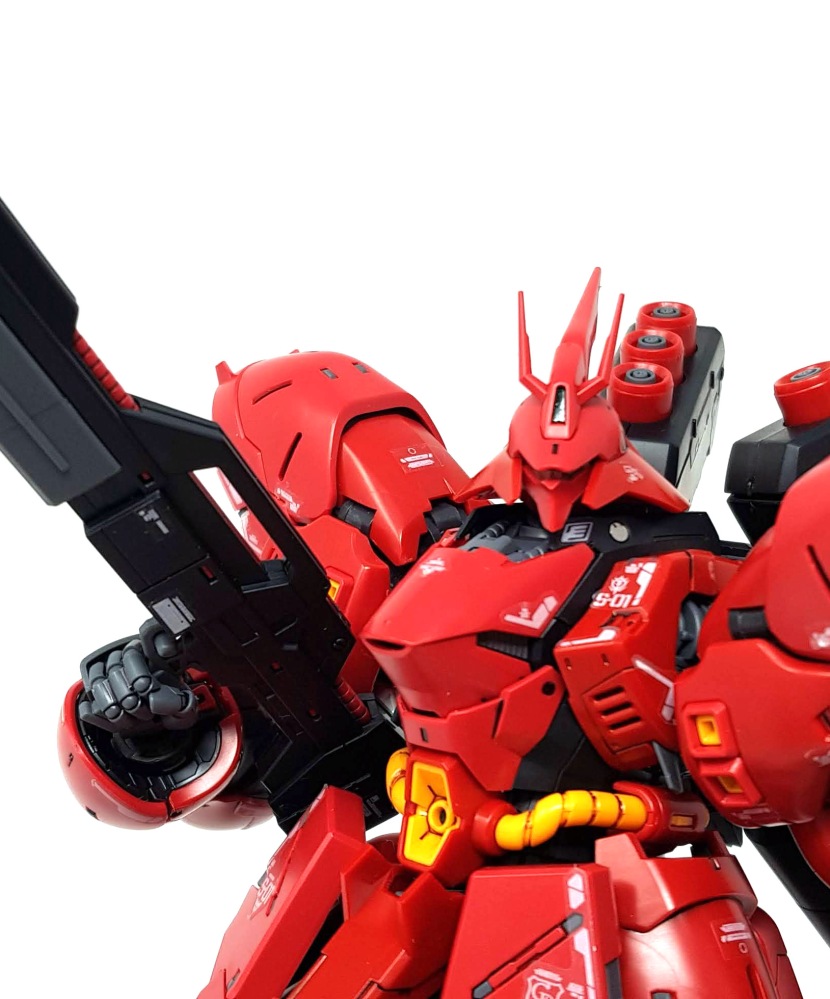
Real Grade Sazabi
After the massive undertaking that was the PG Aile Strike, I was kind of glad to get the RG Sazabi. To this day, I still just snapfit and panel line my Real Grades, and honestly, that’s kinda what I needed right now. Turns out, though, that I wasn’t going to do this one in one sitting like I usually do.
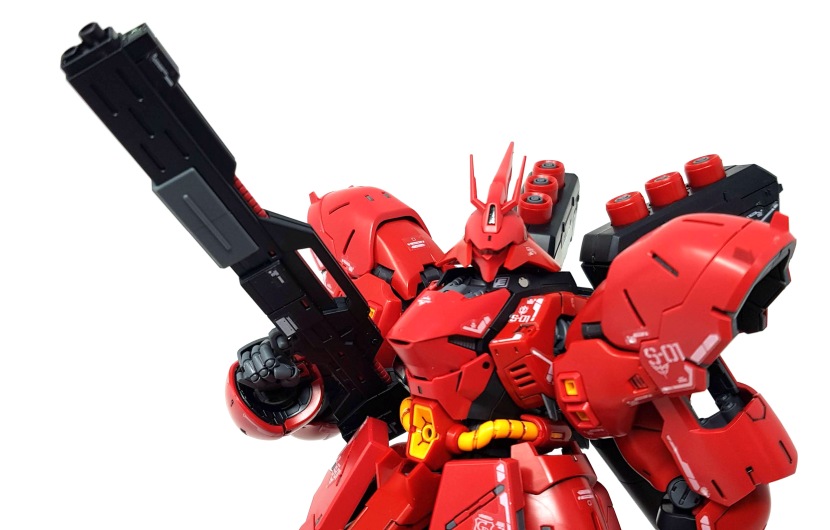
The RG Sazabi is far and away the biggest and most complex Real Grade ever made. I didn’t do the math, but I’m pretty sure the parts count is higher than even the Unicorn’s, and, well, it’s the Sazabi, so it’s gigantic. The box is quite literally the same size as most recent MGs like… incidentally, the MG Unicorn. Everything about this kit is big and crazy.

For example, this is usually the point in my review where I show you a picture of all the sprues laid out nice and neat on my table, but for this one, that was impossible. I had to pile them back into the box like this, sorted alphabetically like I would for a Master Grade. So this’ll have to do for my “here’s what’s in the box” pic this time.
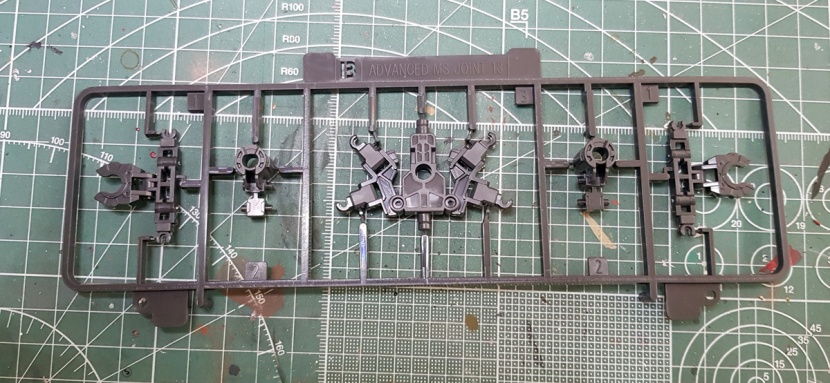
Like on the Tallgeese, the B sprue is practically nonexistent. The part in the middle goes on top of the waist section to hold the skirts, the number 2 parts next to it are the elbows, and the ones on the outside are for the shoulder armor – that’s it. The rest of the joints is assembled like on any other Gunpla kit.
Honestly, I have zero issues with this. Some people might argue that with this being the second kit after the Tallgeese where most of the inner frame is assembled the old-fashioned way, the RGs are losing what distinguishes them from the other lines, but to me, their selling point was always being basically MG-level detail at 1/144th scale, and the pre-molded inner frame parts where just a means to an end.
Also, you might notice just from looking at this that there are sections separated by joints that don’t appear to have their own injection gates, but they actually do; it looks like the second layer of the sprue is removed before packaging as there are clearly visible gate marks on these parts.
Anyway, guess what? The build starts with the feet.
As you’d expect, you put together the inner frame for the foot and the ankle joint, then you plug the armor on top of it.
Next are the legs. Nothing too out of the ordinary here either.
Double jointed knee, a movable flap in the back that the thrusters at the ankle attach to, and that’s that. There’s no sliding armor here and no crazy exploding knee. I’m okay with the latter, but I guess it’s mildly disappointing that nothing at all moves as you bend the knee. Then again, the fact that the legs are as flexible and stable as they are, given the bulk and awkward weight distribution of the bellbottom armor, is amazing enough as it is – it doesn’t need any more gimmicks.
The waist section is next, and uh, yeah.
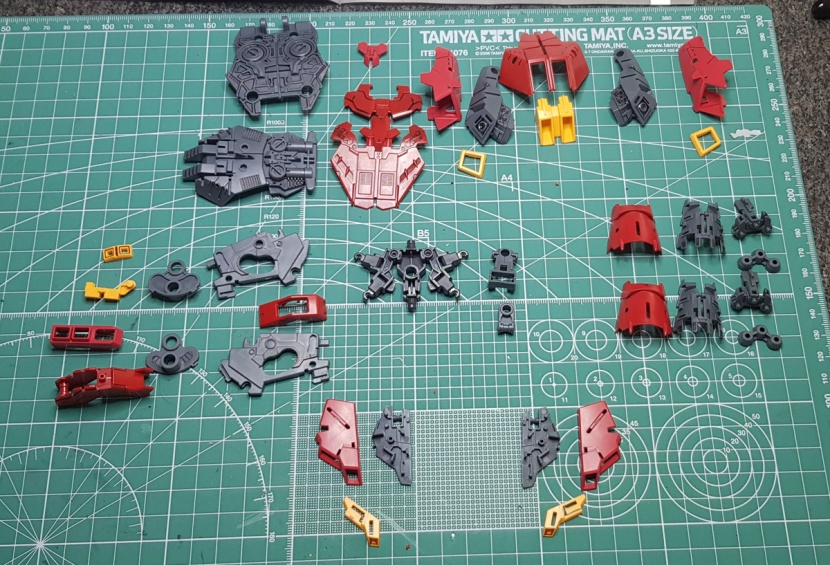
Of course, if you know anything about the Sazabi, you won’t be surprised to see that the waist and the skirts have the combined parts count of a small HG kit (also, as usual, there’s actually a few parts missing in this picture because I’m an idiot.) As you can see, though, that’s not just because of their bulk, but also because there’s a lot of nice inner detail and some opening hatch gimmicks here.
The main section consists of two halves with a swinging hip joint section in the middle, the aforementioned B sprue part that goes on top and is secured in the front and back with two parts that I didn’t photograph separately because cf “idiot” above, and then the armor goes on the outside.
The front skirts are next, consisting of three parts each and with a bunch of holes in the armor for the grey inner part to show and add some really nice color separation. Otherwise, nothing special here – no hatches open.
Next is the massive rear skirt section with opening hatches on the side and a ton of detail. At this point I was starting to think this kit would really be fun to paint and looking at these pictures as I’m writing this makes me ponder buying a second one to do just that.
The side skirts are simpler, but they do also have an opening hatch gimmick. And that completes the waist section.
Next is the upper torso, which is a nice example of economical design. As you can see, it looks fantastic and it’s jointed in two places for a decent ab crunch, but it doesn’t really consist of all that many parts. The tubing, especially, is just one chunk instead of a maddening pile of Zaku beads, but if I’m honest, I think with a little panel lining it looks just as good and it’s more solid.
Also, there’s been a lot of horror stories about the shoulder joints, but I really didn’t have any trouble with them. You do have to make sure you press them all the way down for the armor to fit around them, but other than that, they’re fine.
Next are the arms. Like the legs, they’re reasonably complex and really pretty looking, but they don’t have shifting armor plates. There is a nice little piston detail for the elbow, though. As you can also see in the second to last picture, there is no actual beam saber handle stored in there, just a dummy that makes it look like there is one. Given that the tradeoff is better stability, I can’t say I have a problem with this.
The shoulders are the final section with a B sprue part in them. Internal detail on every armor piece, everything’s articulated to make room for the arms to move, and there’s an open hatch gimmick as well.
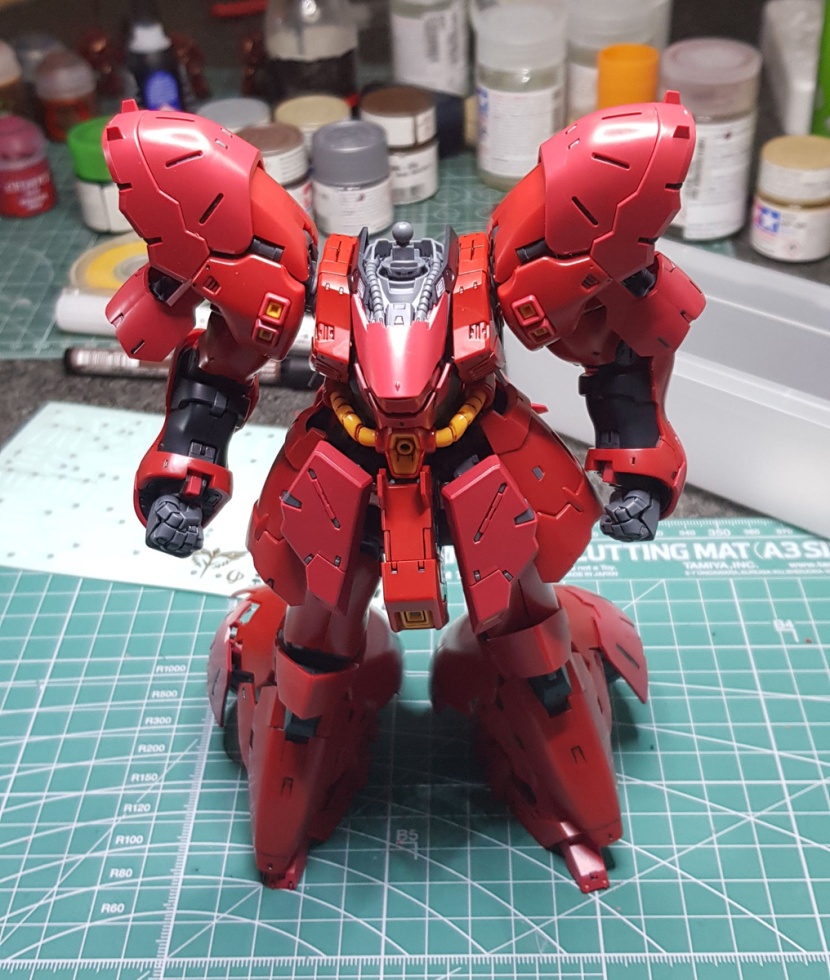 And we have a headless Hessian. I also finally figured out how to get the camera to focus on the top instead of the feet. Sadly, this means the end of a beloved RoboShop tradition, and I’m sure I’ll lose all of my legions of followers over this.
And we have a headless Hessian. I also finally figured out how to get the camera to focus on the top instead of the feet. Sadly, this means the end of a beloved RoboShop tradition, and I’m sure I’ll lose all of my legions of followers over this.
Uh, anyway, here’s the head.
Now unfortunately, I can’t quite show you this to you properly. It’s assembled in sections, as you can see, and has the sphere for the cockpit with opening parts around it, but I ran into a bit of trouble here.
First of all, the t-shaped part for the mono-eye was broken out of the box; the mono-eye itself was almost snapped off. That wasn’t a problem Tamiya Extra Thin couldn’t fix, though. What happened next was that, as you can see here, I decided to try painting the mono-eye instead of using the sticker. As I kind of expected, that came out basically invisible behind the visor, so I decided to take the head apart again and put the sticker on. And at that point, the clear part for the visor broke, and I had to glue the entire head assembly together. It looks totally fine as the broken part is hidden behind armor, but of course it doesn’t open anymore, and I’m always handling it pretty gingerly.
I really think the problem behind both these issues is that the clear parts are unusually brittle, at least for Bandai’s standards. This isn’t usually a problem with their kits, but you’re going to want to handle these carefully.
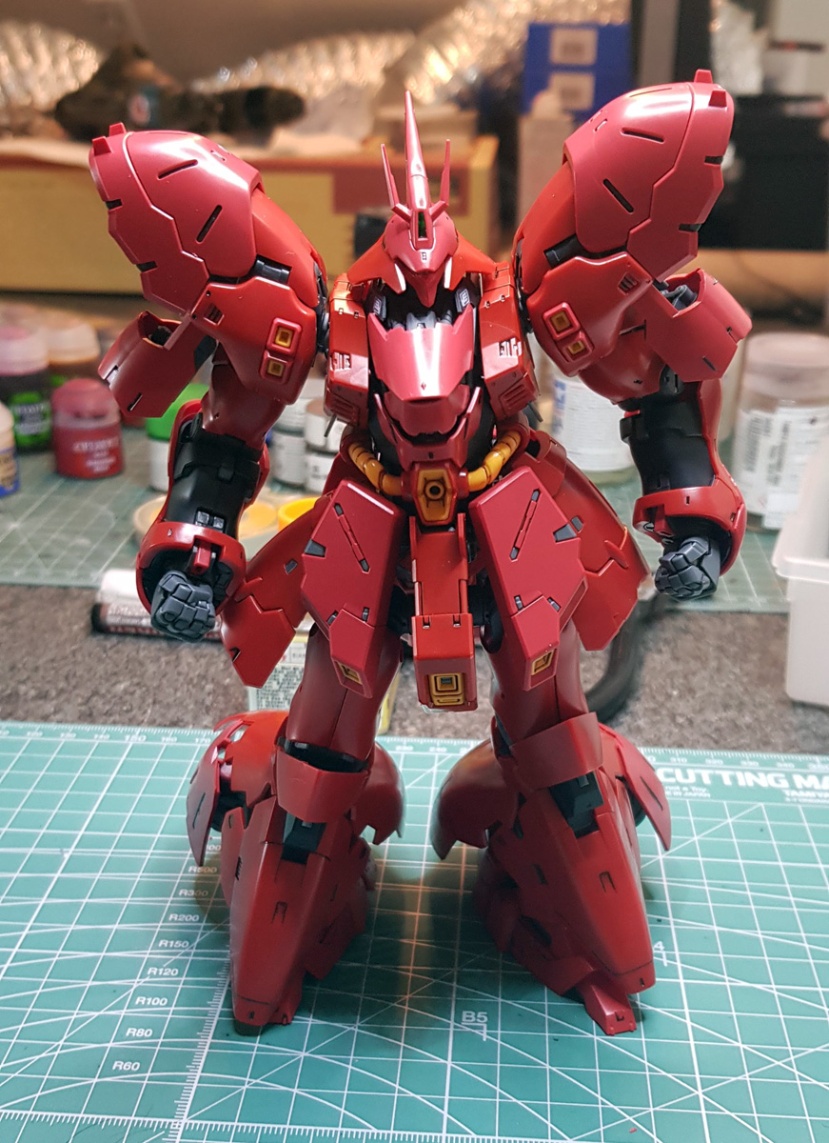
Then you get to the backpack, and I demand that you look at this.
LOOK AT IT.
The good news is, though, that despite consisting of seven parts each and having the full range of gimmicks with the opening side panels and protruding barrel, the funnels are actually less fiddly to assemble than on the MG. The side panels are partially held in place by the grey section on the inside, not just the armor part that goes on top of them, so you don’t have to somehow try and hold all four of them in place as you’re squeezing the top armor section on to secure them in place.
And then the backpack goes together like so. As you can see, it has a nice opening hatch gimmick in the center section, and of course the binders open and close; there’s actually a section that you pull out to open them, but honestly, it doesn’t work that well, and you have to be kind of careful not to open them too far or they’ll explode.
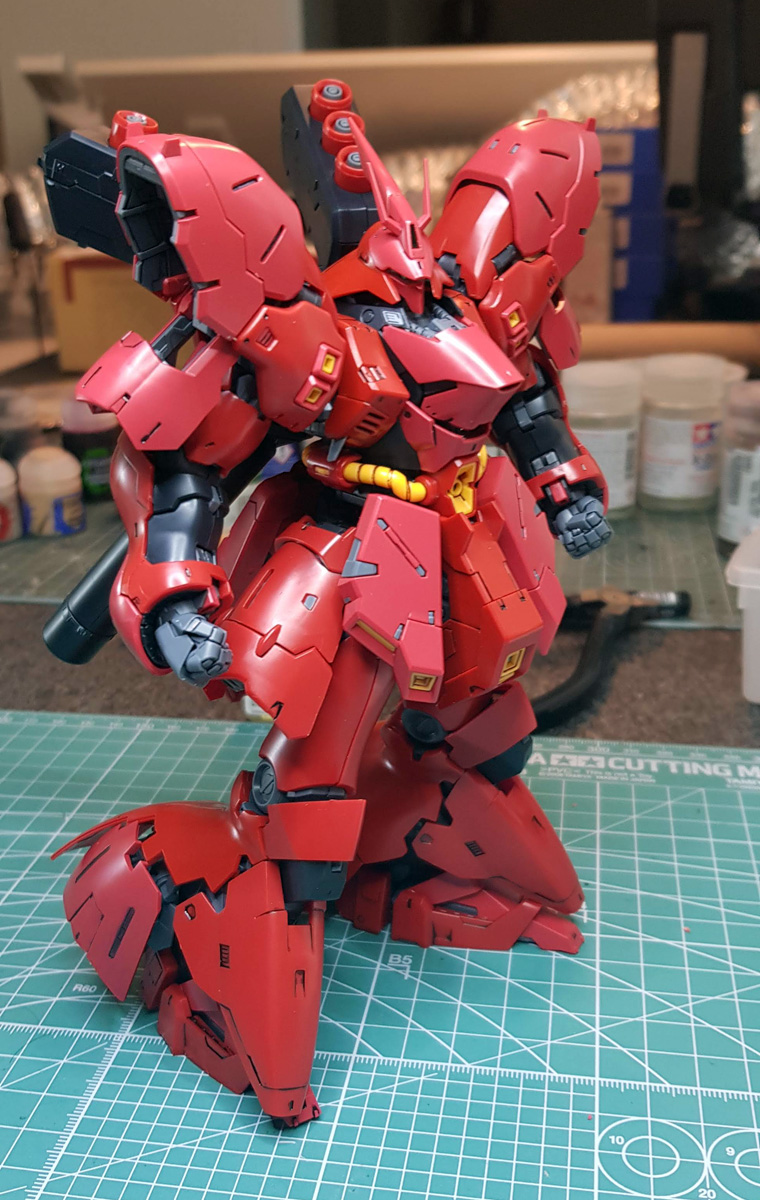
And we’re done. At this point I’d like to point out, purely because I think it’s what really stands out about this picture, that the RG Sazabi has by far the most accurately proportioned shoulder armor out of all the versions of this suit. For my tastes, this is an ongoing problem with every kit of the Sazabi – one of its most striking features in the anime is the bulk and curve of the shoulder armor, and they’ve never really gotten this right. This is definitely the closest any kit has come to accurately reproducing the proper proportions.
And that brings me to the accessories.
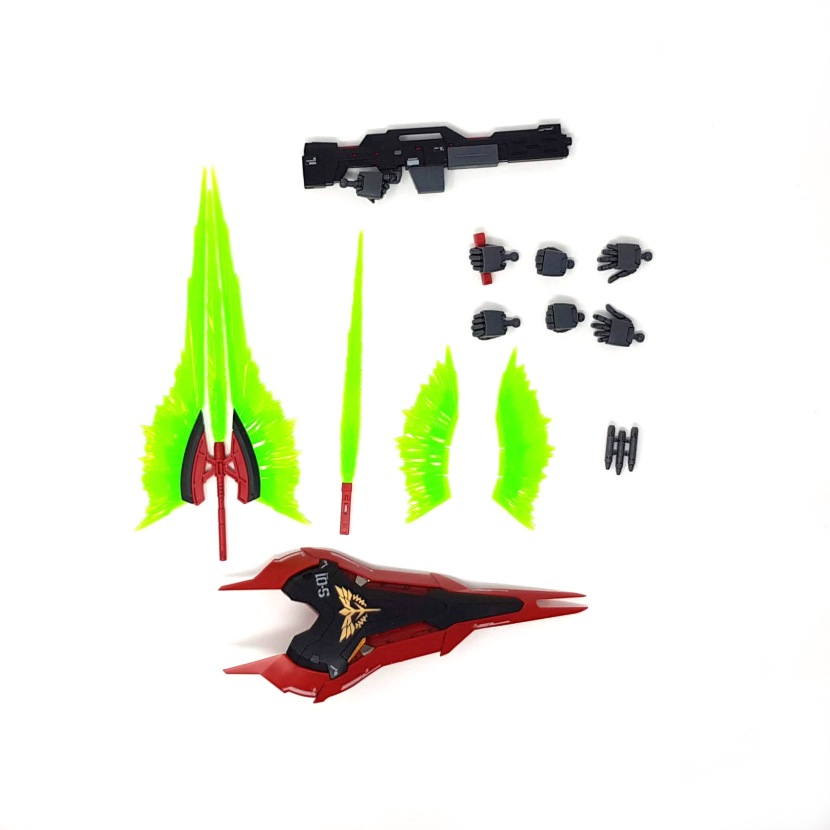
You get the shot rifle, the shield, two beam sabers with effect parts and the beam tomahawk with the long and short effect parts, as you’d expect. The beam tomahawk can also be mounted on the shield. Other than that, nothing attaches anywhere, but it all sure does look damned good. Also, you get a sufficient range of fixed-pose hands to hold everything, two fists and two open hands, and the holding hands have jointed wrists to help with posing. There’s also an action base adapter and a Char pilot figure that aren’t in this picture because I’m too cool to actually take useful pictures that contain all the necessary information.
If I have one complaint, it concerns the accessories, or more precisely the conspicuous absence of the long rifle. As you may know, this rifle is only available as a bonus item with a magazine, and if you’ll excuse my French for a second, that’s fucking bullshit. The long rifle is the gun that most fans of the Sazabi prefer, and to separate it from the main kit (which is expensive as hell for an RG) for a promotional stunt like this is just unforgivable.
Personally, I’ve always preferred the shot rifle, so I don’t need to play Bandai’s game here, but this is honestly the only thing they could’ve done that’s even worse than making the Sinanju‘s bazooka available exclusively as an overpriced P-Bandai add-on kit.
That’s about the only complaint I have, though. As mentioned above, this kit is missing the sliding armor gimmicks that have been a staple of RG design for as long as the line has existed, and I’m not entirely sure how I feel about the fact that that’s apparently a thing of the past, given that the Tallgeese also didn’t have it. I always liked it, but these two kits just seem to be considerably more sturdy because of the way their inner frames are put together, and if that’s the tradeoff, I think I can live with it. It’s not like they’ve otherwise scaled back the detail or complexity – this was the first time I had to split an RG build over several days, and at the same time, very little about it was fiddly or difficult, it’s just a lot of stuff.
And as you can see, poseability is excellent, given that this is the Sazabi. I can’t honestly say that I like this more than the MG Ver. Ka because it just doesn’t quite have that kit’s level of detail, but it does have the improved proportions and both the poseability and stability to allow you to display it in the kinds of dynamic poses you actually want out of a Sazabi.
In conclusion, I think we have a new best Real Grade kit. This thing just doesn’t have any flaws. With the Unicorn, I really think there’s an issue with the proportions, but this one actually has better proportions than its predecessors, if anything, and sacrifices absolutely nothing in terms of posing, stability, sturdiness, and general fun factor both during the build and posing it for this photoshoot. Absolutely fantastic kit – get one if you can, they’re selling like hot-cakes for a reason.
And by the way, I know the damned ammo clip is missing in every picture with the gun, but “I’m an idiot” is the theme for this review, in case you hadn’t noticed.
Sigh.
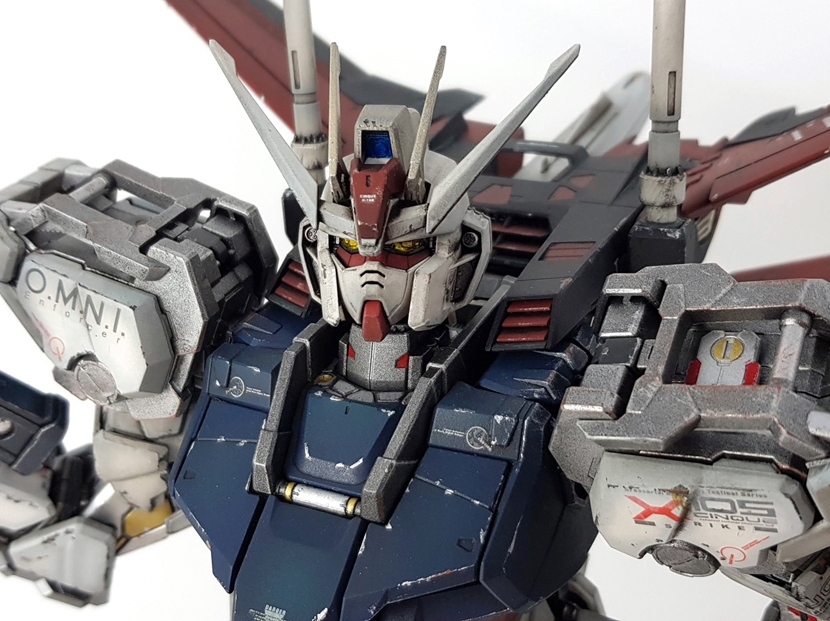
Perfect Grade Aile Strike Gundam Painted Build, Final Review
Those of you who follow this blog regularly should probably both know that I will be repeating some things here that I already talked about in the WIP updates and on Youtube – the only thing that’s new is the Aile Striker and a few more accessories. So you might want to scroll down to that part, although I do have a few new pics along the way.
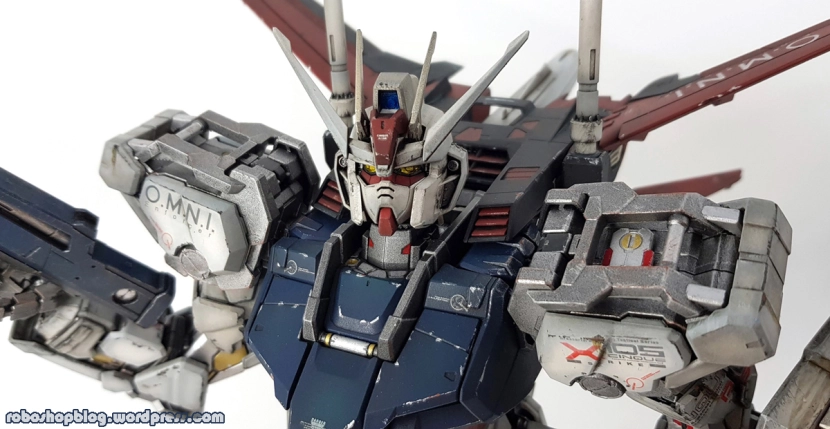
My usual philosophy is always to try something new on every build, but with this one I took a slightly different approach. For a number of reasons, among them the fact that it’s a frickin’ PG and complicated enough as it is, I decided to treat this more as a milestone build and just throw every technique I’ve learned over the past year and a half at it. Things I know will work, basically. That’s why, for example, the color scheme is the same as on the Master Grade Mk-II – that’s my personal version of the Gundam colors, I know I like the way it looks, and so I used it again here.
I still ended up doing a few somewhat new things – that just seems to happen kind of inevitably. I’ve never actually done a gunkwash over pre-shading, or on any painted Gunpla, for example, or this much detail painting on the inner frame, or this much masking. But that’s just more of familiar things or combinations of techniques that I’d used before.
The general process here was basically the way I approached the RX 78-2. I painted and weathered the armor first, then took it all off again for topcoating, and dismantled and painted the inner frame.
After priming, I pre-shaded the white and off-white armor pieces with light grey and the red ones with black. The blue pieces were primed black, painted flat and then highlighted with my own custom mix of blue and green that I’ve used before on the Mk-II.
The big news here is that I really think this one is the build where I finally got my preshading dialed in. As you’d expect with anything airbrush-related, most of it had to do with mixing ratios. I figured out that I needed to thin the shading paint much more than I usually would so that it would spray evenly at low pressures and not give me specks all over the place, and then just be, y’know, really really careful not to produce any spidering because the paint was so thin. If you’ve been following this blog, you should know that preshading has been sort of an ongoing struggle for me – I’ve always loved that heavily preshaded Japanese style of painting, but I could just never quite get it right, so getting the look I wanted, and on a complex kit like this, is really satisfying.
Anyway, after the pre-shading, I sprayed my usual custom mix of Tamiya’s red and red brown over the red parts for that muted look, white for the white parts and a mix of white with a few drops of light grey for the off-white.
The next step was a gloss coat and then waterslides. Because Bandai refuses to make waterslides for their PGs, I had to resort to third party again, but I’m very happy to report that the ones I used here, from DL, turned out to be almost as good as Bandai’s. The print quality is excellent, they’re pre-cut with razor-sharp precision, and they’re very easy to work with. Although that’s partly due to their one downside, which is that the carrier film is just a teensy bit too thick for my tastes. That means it’s easier to move the decals around and not have them crumple up and fold in on themselves, but they just don’t look quite as painted on as Bandai’s.
After decals came another gloss coat and then a gunk wash with Abteilung 502’s Starship Filth. Here I ran into my first real problem with this build. Like on the Storm Sworder before, the surface quality of the gloss coat wasn’t quite as slick as it should have been on all the parts, and I was more concerned with not filling up the panel lines, so I didn’t fix it. Turns out that on light colors, the difference in how the oil paint tints the color when you wipe it off becomes more pronounced, and it also became an issue that the shaded and plain areas had different surface qualities that still poked through the topcoat. I was able to fix this more or less by using a little oil paint thinner on those pieces where the paint wouldn’t wipe off as much as I wanted to, so I ended up with reasonably uniform shades of white and off-white, but it did affect how much of the Starship Filth remained in the panel lines and crevices, and so now the panel lines aren’t as uniform as I would’ve liked them to be. Not a huge issue because gunk washed panel lines definitely read more like a weathering effect and thus shouldn’t be entirely uniform anyway, but definitely a lesson learned for future builds.
After the gunk wash came another top coat, and then I could finally slap the armor back on the still unpainted inner frame to see what it all looked like.
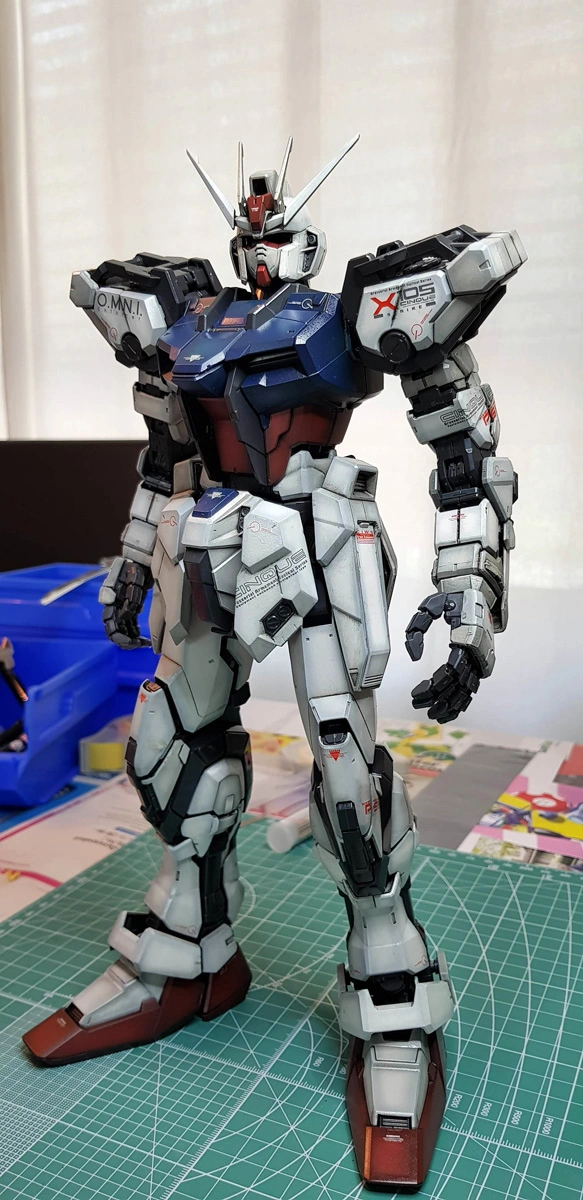
And it’s a good thing I did because seeing it all put together like this, you really notice that between the preshading and the gunk wash, it already looks very faded and worn, and you could really leave it like that. I had already resolved at the start of this build that I wasn’t going to weather the kit as heavily as I usually do, but this test assembly made me restrain myself even more. In fact, I still like this look so much that I’m probably going to paint another kit like this soon and not do any further weathering.
So I did the usual, just less of it. First I drybrushed all the edges with the base colors for highlights, and then I went back to chipping with a detail brush instead of drybrushing all over the place. I’d previously done this successfully on the Gun Sniper and, let’s say, less successfully on the RX 78-2, but it was clear that the drybrushed approach was going to be too much here. I only drybrushed scratches in a few places like on the feet or around the shoulder joints where I thought more wear and tear would occur, the rest is all done with a tiny brush and lots of patience. I must say I’m pretty pleased with how it came out, although of course it’s also a bit easier on a larger scale kit.
The colors were the usual – Tamiya chrome silver for the red and blue, gunmetal for the white and a few dabs of Gunze’s rust here and there. Then I drybrushed the customary heat streaks around all the vents and the head vulcans and added just a small handful of rust streaks with Vallejo’s Dark Rust and diluted india ink, basically to some of the bigger chips that I had previously added a dot of rust to as well. When I decided to add a bit of Vallejo’s Engine Grease to have grime streaking out of the knee joints, I started to run into trouble (the streaks on the left shin are much more than I wanted), so I took that as my sign to stop. Well, actually, I also sponged some Tamiya Brown/Light Grey on the feet and then stopped. I did mention I repeated almost every single technique I know here, right?
Here are a few pictures of weathering details from the finished build. Obviously this was after I’d also painted the inner frame. With just the armor painted, it looked like this.
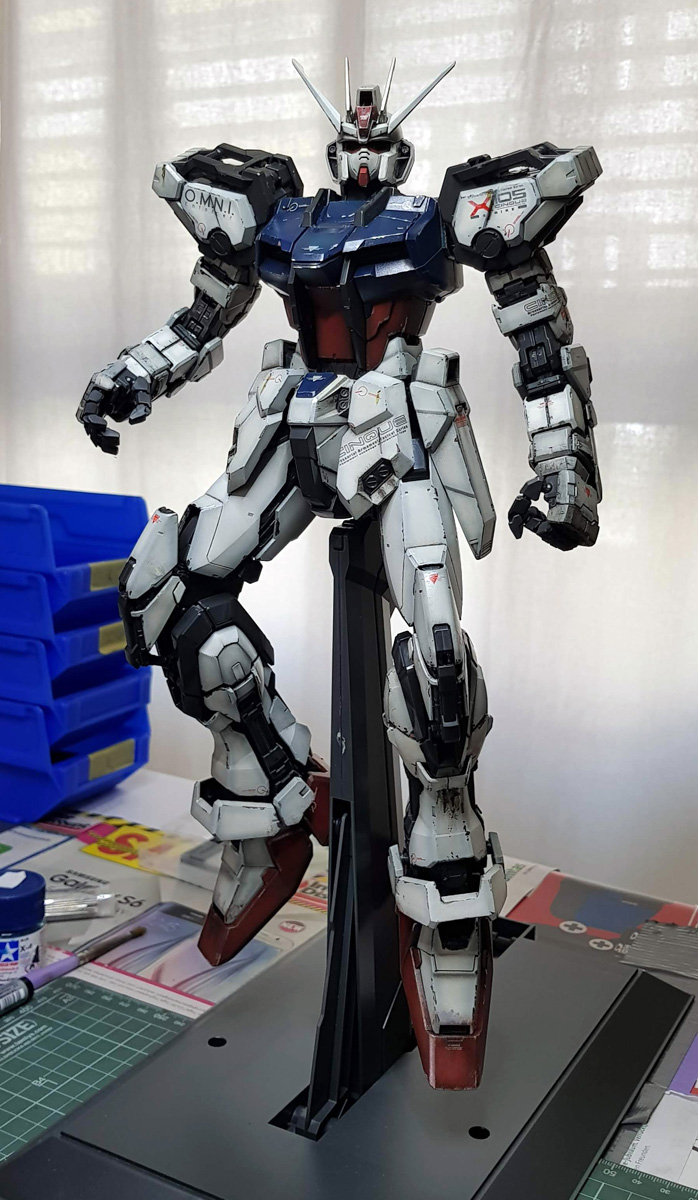
And then I had to take it all apart for topcoating and to finally paint that inner frame. First I snapped a series of reference pictures, though, so I would remember which parts of the inner frame would be visible; I did want to do a fair bit of detail painting, but I had no intention of doing a full paintjob on the inner frame just so I could take a few pictures and then hide it under the armor forever. It’s awesome when other people do that, but it really just bugs me when I spend a lot of time on stuff that I then can’t display, even if I’m almost the only one who ever looks at my shelves anyway.
The general approach with the inner frame was first to settle on a relatively simple color scheme – gunmetal over black primer as the base color, then chrome silver, gold leaf and red for details. There are a tiny handful of parts that I base painted in silver or gold, but almost everything was painted gunmetal. Then I made sure I painted similar looking details in similar colors; gold for pistons and round screw-like parts, silver for raised panels, and red for smaller tubing and a few recessed squares that I decided might be lights. Finally, I drybrushed everything silver on the gunmetal and white on the gold and silver, plus rust on everything.
As you can see, the end result was that it gives a nice sense of depth and detail to the inner frame where it shows through the armor plates, and a few cool effects with mechanical detail being revealed as the joints are moved, especially in the knees. The legs in general I’d say are not only my favorite part of this kit engineering wise, but also where I probably did the best job with the details, but it was also easier because there’s so much cool stuff to work with.
Another new trick I learned here was to paint the frame in sections; I did the torso first and then one limb at a time. This allowed me to keep one limb completely assembled as I worked on the other one, so it was much easier to see what goes where and how it should be painted. I don’t know if I’m going to repeat this approach on the next MG I build, but for something this complicated, it really helped.
And then I could finally slap the armor back on and put it all together.
And that brings me to what you all know it brings me to – accessories.
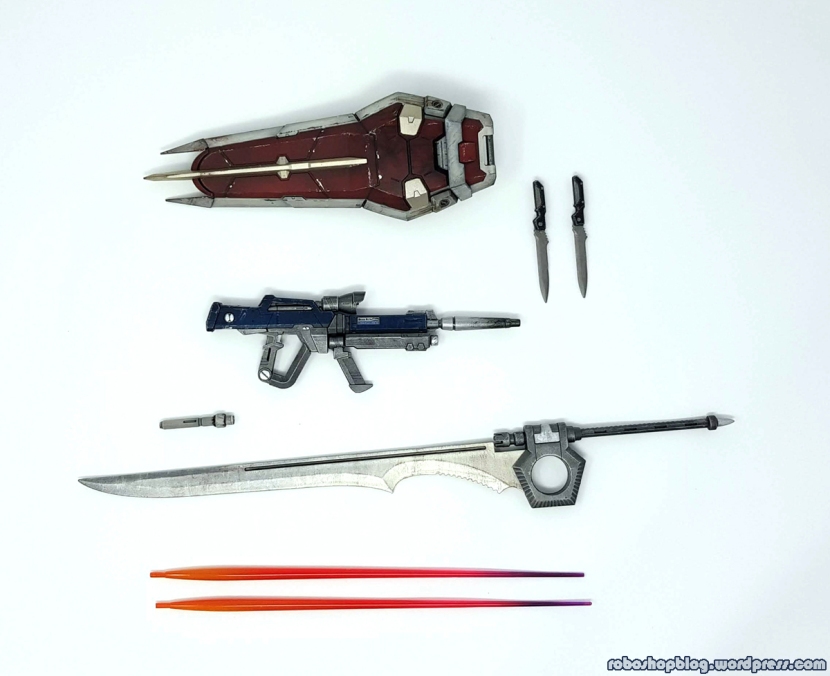
With the base PG Strike kit, you get the beam rifle, the shield, the Grand Slam sword and the Armor *snicker* Schneiders. The beam sabers are included with the Skygrasper/Aile Striker kit, so I tossed them in this picture here.
I painted the inside of the rifle gunmetal with a few silver details here and there, especially the barrel, which needed to be masked. The outer casing is the same blue over black with highlights, drybrushing and a gunk wash as on the suit, just with a lot more drybrushing because I thought the weapons would have more wear and tear. The camera is clear red on the outside and silver on the inside, and I did the usual soot/heat streaking around the muzzle. I’m thinking on a future build I’ll try actual heat discoloration, but you know what the theme for this one was.
The shield is the same red and white with pre-shading as on the suit, titanium gold for the yellow parts and gunmetal with a few silver details for all the mechanical stuff, including a few details and the handle at the top that I painted at the end, as usual, to keep them shiny. As you can see, the inside of the shield is gunkwashed with a lot less cleanup than I usually do to give it this dirty appearance. There’s also pre-shading under there, but you can barely see it anymore.
The mechanisms for the moving handle and the small blast shield were a bit of a problem. I left the clip the handle attaches to unpainted, but it’s so tight now that I don’t really want to move it anymore. And the blast shield was hard to move before the shield was painted, so I knew I’d have to sand it down a good bit, but even after doing that and a lot of test fitting before I assembled everything, it’s still hard to move.
Oh yeah, and the clear part in the… I dunno, the peephole, has the same light grey sponged-on dirt I usually do on canopies.
Since I don’t particularly care for the Grand Slam sword and the Armor *snicker* Schneiders, I kind of broke with the theme for this build and used them as an opportunity to experiment a little.
The tennis sword, of course, comes with a chrome coated blade, and once I had painted the handle and put it back together, it became 100% clear that it looked unacceptable. Bandai’s mekki plating is nice and all, but next to properly painted parts, it just still looks too toylike.
That left me with the problem of having to strip the plating off the part, which I’d never done before. After two failed attempts with bleach and a mild degreaser, I bought a bottle of concentrated car degreaser from the local hardware store, soaked the blade in the stuff for a few hours and poof, gone was the chrome coating with zero damage to the part. I’m really glad to finally have found a product that does this for me, and I’m thinking I’ll use it to strip paint in the future as well.
Then I primed the blade with Vallejo’s gloss black primer that I’d discovered while I was working on this build and thus hadn’t used elsewhere.
And then I decided to just try some silly stuff and see what it’d look like. I also bought a few of Vallejo’s Metal Color paints to experiment with, but I decided to stick with the Tamiyas so it wouldn’t clash too much with the other metallic stuff on the kit (which is dumb and I’m dumb for doing this dumb thing, I’m just explaining my reasoning.) But instead of just painting it straight chrome silver, which seems like the obvious thing to do, I first painted the whole blade gunmetal, then added a gradient of gold leaf from the hilt, then a thin coat of chrome silver on top. This ended up doing exactly what I’d hoped it would, which was the illusion of an iridescent surface; you can’t quite tell what color it is because the lighter areas with the gold underneath seem to be that way because they’re catching the light, but they’re actually not.
But of course that looked too pristine, so I drybrushed all over the blade with silver, titanium gold, gunmetal, white and rust to make it look all beat up. It kind of ended up taking away the iridescent effect, and now it looks more like it’s so worn that you can’t tell what color it is anymore, which is also fine.
In fact, I now like this sword so much that it kind of sucks that I can’t use it.
The armor tailors, as I’ve complained about before, are a problem because they come pre-assembled on the same sprue as the hands, which makes it unnecessarily hard to paint them. When you really think about it, though, even if the blades were separate pieces, the first time you fold them, you’d scratch half the paint off of them anyway, so it really doesn’t matter.
Now I could’ve masked the handles and airbrushed the blades, but I had just picked up some Citadel paints and decided to give those a try instead. After all, the worst thing that could happen was that I’d ruin an accessory that I wasn’t going to use anyway. The only reason I painted these in the first place was because the idea of not having painted everything that came with the kit bugged me.
So I used Lead Belcher, which seems to be sort of the go-to silver color in the Citadel range, on the blades and the detail on the handles. I have to say this stuff is almost as good as I hoped it would be. It still takes about three coats to get a good even finish and you still have to be careful to get the thinning ratio just right, but it’s a hell of a lot easier to do than with Tamiya acrylics, and the end result looks about as close to airbrushed as any hand painted surface is ever going to look.
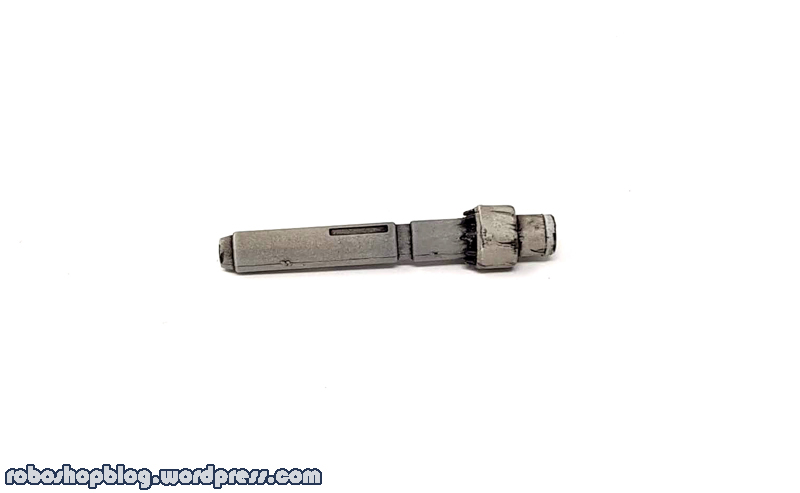
Not much to say about the beam saber handles. The part that I guess you’d call the cross-guard is nicely detailed, so I painted those parts gunmetal, and I did the usual heat streaks (because beam saber blades cause heat streaking because science and no, I’m not going to stop running this joke into the ground), and of course they’re pre-shaded, gunkwashed and chipped.
You might also notice in the picture that the paint is basically stripped towards where the effect part plugs in – that’s because the slots they fit into on the Aile Striker are too tight. I may go back and remedy that with modding, given that I have a second complete Aile Striker kit, but for now, um, yeah.
As for the effect parts, I had that same reaction to them as I did with the Grand Slam blade where it suddenly bugged me how toylike they looked in unpainted form, so…
The original idea was to paint them clear yellow at the bottom, but that didn’t work at all. Lighter clear paint on darker clear parts does basically nothing. So I added a gradient of lemon yellow instead and kept it very light so as to not go fully opaque, and that worked very well.
I then painted the tips blue – the idea was to have a gradient from a warm to a cool color here, basically, and while that makes sense in theory, I kind of feel like the purple that resulted from painting the tips makes the parts look a bit too much like candy. I’ll probably do the yellow at the bottom again, but no more blue on the tip.
And that’s our opportunity for another pose gallery. I think the only thing I have to say here is that if you don’t want to shell out the extra bucks for the Aile Striker kit, you’ll still get a heck of a PG with the Strike.
But as far as this build’s concerned, saying that is just my segue into talking about the Aile Striker.
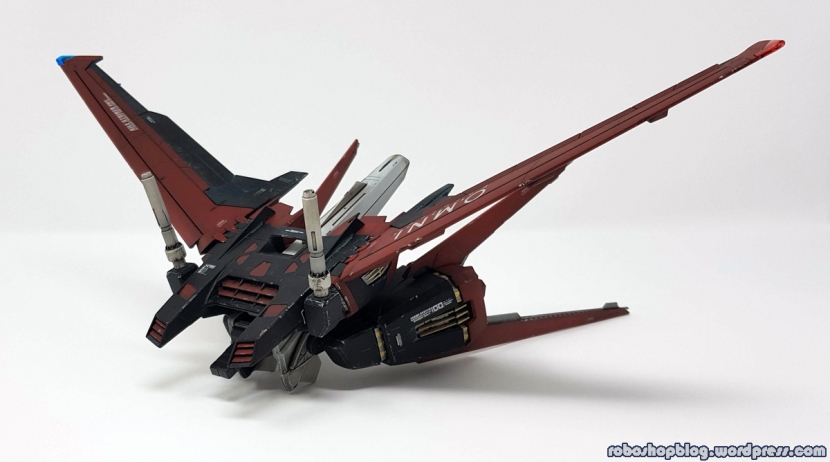
Now the first thing I needed to figure out was something I had basically been putting off since I originally snap built the suit itself. Back then, I promised myself that I would snap it together before I started painting anything to make sure I had a clear plan for the color scheme. Well, I didn’t. And what I’d never figured out was what to do with these dark grey parts that are molded in more or less in the same color as the inner frame of the suit.
One thing I considered was gunmetal, but that would have raised a whole host of problems with glossy and matte surfaces right next to one another, and I also thought it didn’t really make sense for the outer hull here to be the same color as the inner frame elsewhere. So I ultimately settled on black, despite the fact that I hadn’t used black anywhere else on the kit.
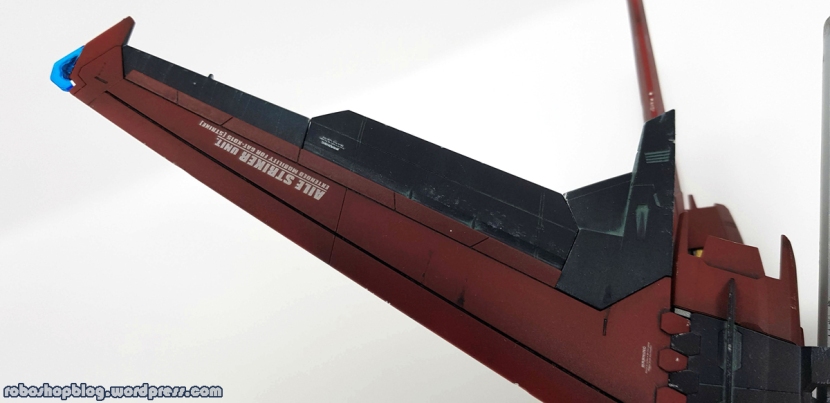
Now that in itself was fine, but now I had to figure out how to weather this stuff. What I’d normally do with black is just drybrush silver all over it, but that results in a much more heavily weathered look than what I wanted here. So after some experimenting on spoons, I decided to do a gunkwash instead, with Abteilung 502’s Ghost Grey. That’s how I got these bluish-grey panel lines and the accumulated dirt in the recesses that you see here.
That was followed by edge highlights with Tamiya light grey and some chipping.
Now as you can see here, I also did some masking to add color separation. I have to say if there’s one disappointment I have with these two kits, it’s the lack of complexity in the Aile Striker (and the Skygrasper, for that matter.) Its proportions are about as perfect as they possibly could be, but just out of the box the lack of color separation makes it look really bland and toy-like. So I just painted some of the detail in the same red as everywhere else.
The rest was fairly straightforward and just followed the color scheme and weathering steps of the suit itself, really. I also added a few extra decals to break things up, and of course the position lights on the wings are painted with clear paints. No silver on the inside because I figured it’d just scrape off when I attach the parts.
And with that, the build was finally complete, at least until I decide to make the base more interesting.
I really feel like this is my best build yet by quite a large margin. There are mistakes and things I’d do differently if I could do it again, but the overall result is about as close to what I wanted as it could have been. I’m especially happy about the fact that I pulled off the more restrained approach to weathering that I wanted to take here, and seeing the result of that has definitely taught me a lot about how important it is to apply weathering in moderation and how the different stages complement one another. And as for the “milestone” approach, it’s probably not that surprising that I still ended up having to try new things.
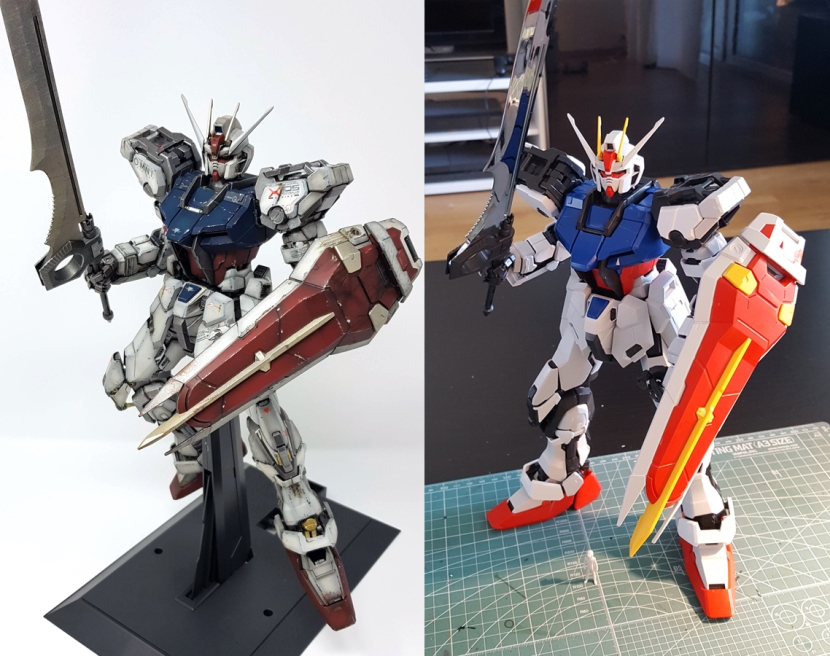
Now as I’m writing this, I’ve already got a list of new techniques in my head that I want to try, and old ones that I want to go back to and give another whirl, so while I may have been a bit worried that throwing everything in my toolbox at one build would end up make me feel burnt out, it’s actually done the opposite. I dunno, guys, there’s just nothing negative about this build, it’s been an absolute blast working on this, and it’s made me a better modeler and hungry for more. I hope you all at least get a kick out of looking at the pictures.
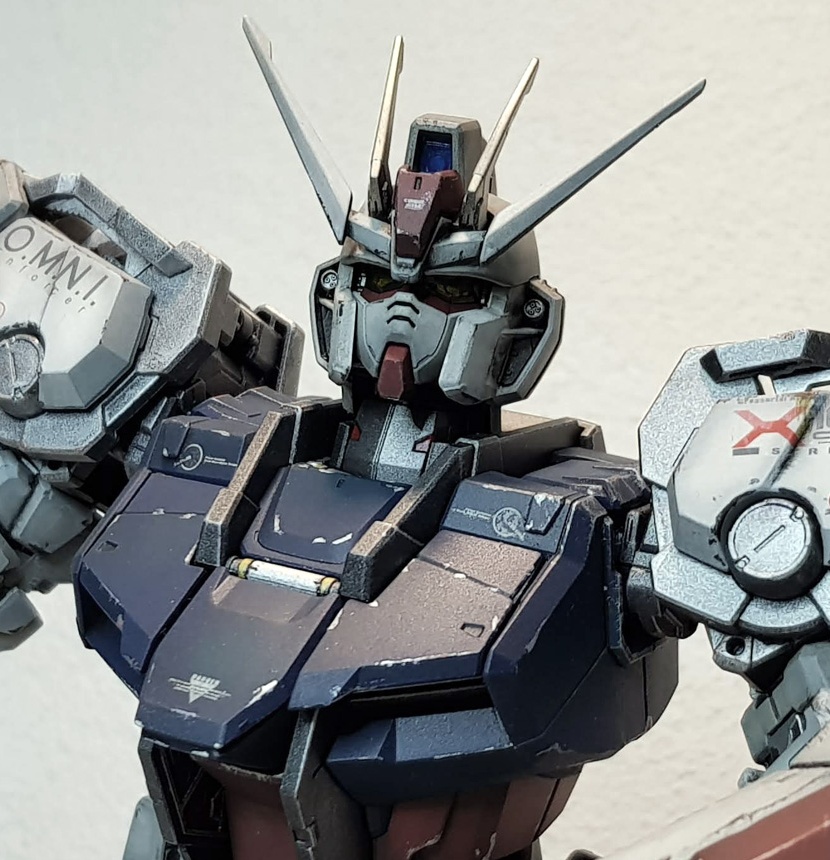
Perfect Grade Strike Gundam WIP 2
Sooo…. after trying and failing to get decent pictures taken yesterday, not to mention I realized I forgot to take pictures of the “naked” inner frame on the limbs, I did a little better today. Truth be told, I’m still not entirely happy with these pics, and I’m a bit worried about how I’m going to do a decent photoshoot with this thing once it’s all done, but it’s good enough for a WIP update. Like last time, you can also check out my progress on Youtube.
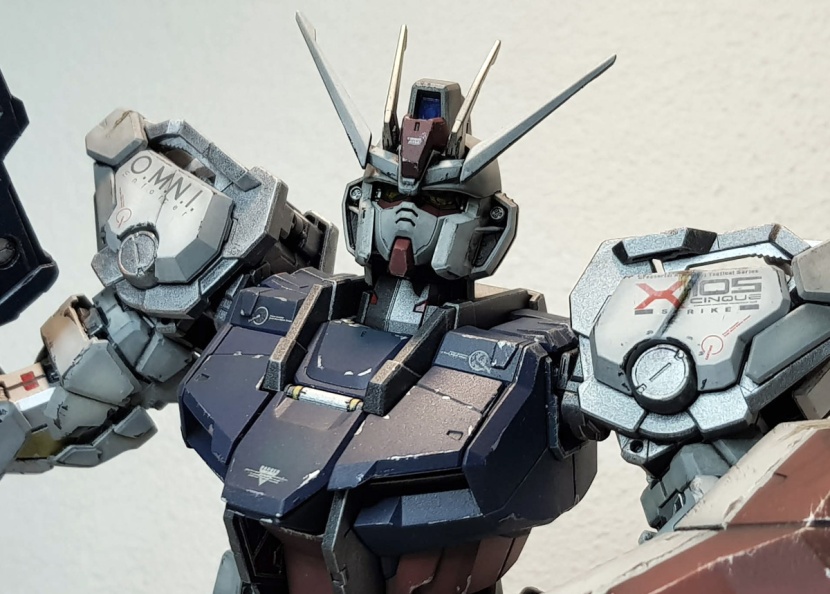
After sort of half-heartedly plugging away at painting the armor on this kit for literally months, I suddenly felt motivated now and actually got the entire rest of the inner frame done in about a week. I think finally seeing the torso and the head put together just made me see the light at the end of the tunnel, and I was also really happy with how it came out and wanted to see the kit finished.
Which isn’t to say that this build is done – as I’m writing this, I’ve started working on the Aile Striker, and I still think I might want to paint the base. I also finally managed to get the chrome stripped off the Grand Slam blade, so I’ll paint that as well, though I don’t know if I’ll have any use for it in the end, to be honest. And I might still paint the Armor *snicker* Schneiders, but that’ll really just be so I can tell myself I did everything. I have zero use for these stupid things, and I don’t see how I’m going to keep them foldable, so I also can’t stash them in the skirts.
Anyway, here’s what the legs look like.
My approach here was basically to decide on a color scheme first – silver, gold and red, all Tamiya. Then there had to be some sort of internal logic to how I painted the details. It’s not like any of this stuff actually does anything, but painting similar details in the same colors, I find, helps it look more like it could be actual mechanics. So pistons and all the round screw-like parts were painted gold, and I used red for small pipes to make them look a bit like they might be thick electrical wiring. I also used red for some recessed rectangles because I thought maybe those are lights; this isn’t a train, after all, it’s a robot from the future, so I’d think it has all kinds of electronic doohickeys making it work. And finally, silver for raised panels, basically to add some depth to things.
What ends up happening once the armor’s on is that a lot of the gold and silver sort of half shows through the gaps in the armor, which is exactly what it wanted; it suggests that there’s all kinds of moving clutter under there. And some of the detail, especially all those red tubes in the knee, only shows up when you bend the joint. To me, this suggests that this stuff is a bit more fragile and so has to be in a place where it’s covered by armor most of the time.
All of this was hand brushed with the exception of the silver on the back of the knee. I airbrushed those parts silver first, then masked off the area that’s silver now and sprayed gunmetal on everything else, followed by the red and gold details.
The hand brushing worked well enough , but as everyone knows, Tamiya paints are kind of a pain to hand brush, and I’m going to give Citadel a try soon. Tamiya’s are fantastic for airbrushing, but I’m really sick of dealing with how poorly they hand brush.
I’m also not entirely sure how I feel about the way the drybrushing affected the detail. On the one hand, it hides some of the imperfections, but up close I’m never quite sure if that’s really what it does or it just makes everything look messy. I got some of this stuff to look pretty sharp, and now… I dunno. I think I’ll try to go more subtle with the weathering next time I do a lot of detail painting.
The arms got basically the same treatment, but there are fewer parts and generally a lot less detail that’s actually visible, so there was just less to work with. My personal favorite is the gold piston that’s facing inwards on the lower arm armor and only really shows when you bend the hand away from it.
I really should have painted that gold panel on the elbow gunmetal instead, though. The way I went about everything was, I completely dismantled one of each limbs and kept the other one intact so that I could use it for reference, so with about 95% of what I did, I was sure of where it would end up and what it would look like, but it just didn’t occur to me that the gunmetal I painted on the elbow joint would read as being a different material underneath the silver showing up in gaps, if that makes sense. Not to mention, as you can see, the bicep armor has already damaged the gold. I’m pretty sure this is the only place on the kit where I have this problem. I guess I can get away with pretending it’s weathering (the armor really would scrape there), but… ergh.
For the most part, the one limb at a time approach worked really well, though, and I certainly recommend it for complicated kits like this one. I also don’t think it made it at all more time consuming, I could actually get through the second set of limbs pretty quickly because I had them all figured out from doing the first two.
Some of the opening hatch gimmicks don’t work anymore – the sliding panels on the chest, as I said in the last blog, and unfortunately also the cool looking ones on the legs that flip open to the side. I decided pretty much during the snap build already that those weren’t going to be useable – even unpainted, I could only ever open them with a toothpick, so they would’ve needed to be modified to keep them functioning, and I don’t think I’m going to be displaying the kit with the hatches open much. I did want to do the ones on the shoulders, though, just because the detail underneath looks so cool.
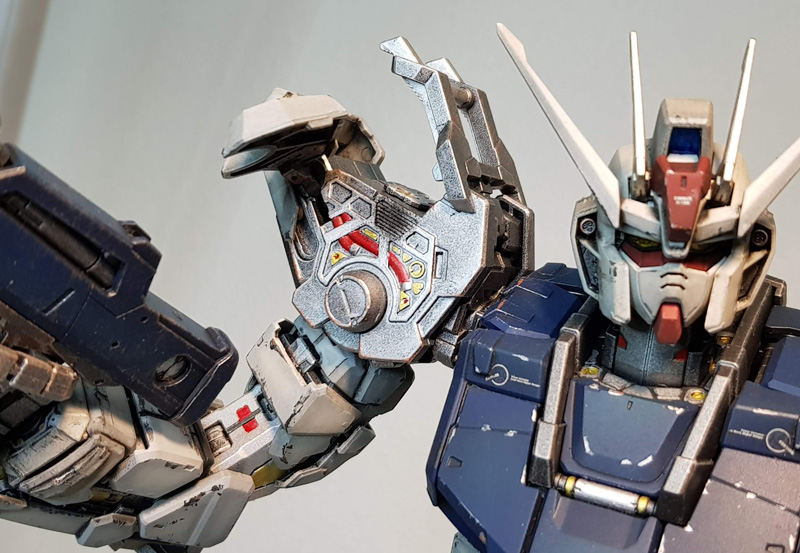
Nothing you wouldn’t expect, of course – red tubing, silver raised detail, gold for some of the smaller stuff. I also masked off half of the outer flap that the thruster sits on so that it could be gunmetal on top and silver at the bottom.
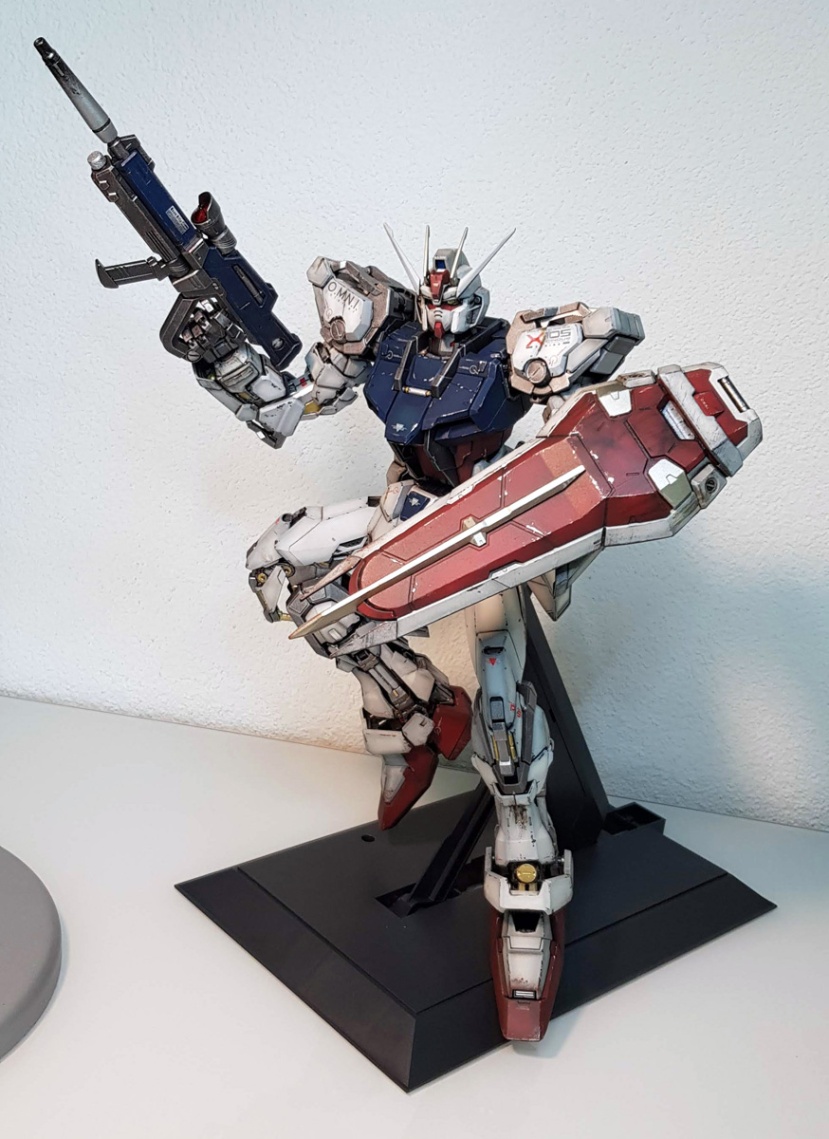
And this is where we are as of now. I don’t know why it’s so hard to get a good picture of this guy, you’ll just have to believe me that this is one of about 30.
Anyway, overall I’m really, really happy with how this is coming along. I’m spending a lot of time bitching about all the small mistakes that bother me in this blog, but being honest with myself about what did and didn’t go well is how I get better. And with all creative work, that’s ultimately the only thing that matters to me. Not to be the best modeler out there, but a better one than I was yesterday.
Also, I really have to say again what an absolute joy this kit is to work with. With the exception of what the elbow did to itself, everything here is so well designed that it still works fine after painting (although I did do a lot of masking on the moving parts, obviously), and despite it being an extremely complex kit, it’s just fun, top to bottom, and it looks amazing.
We’ll see when I can post the next update here – I won’t be around much over the summer, so I’ll just be chipping away a little at a time on the Aile Striker from here on out. I’m kind of hoping I can do something or other with the release of Zoids Wild, but not before the start of July.
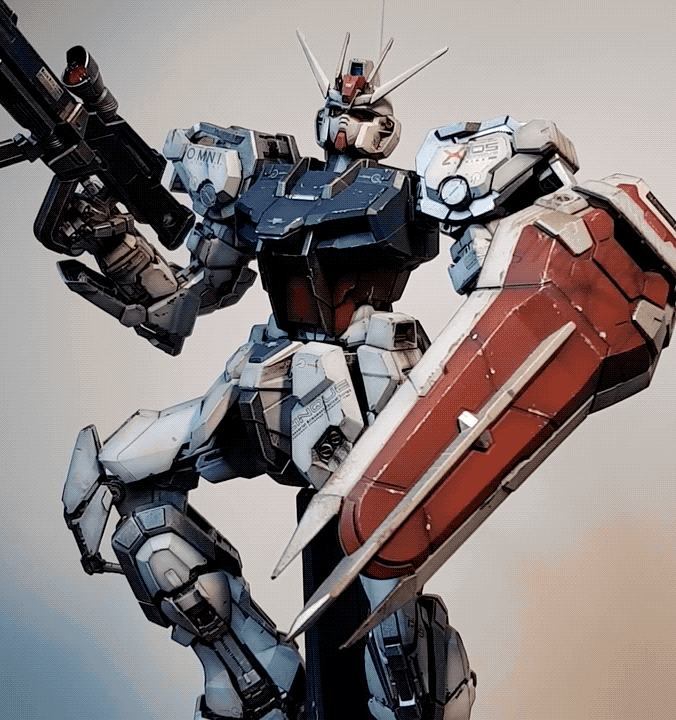
Perfect Grade Strike Gundam WIP 1.5
I wanted to post a huge WIP update on my Strike today, but as it turns out, I’m having rather massive problems getting decent pictures taken of this damn thing because it’s too big. So instead, here’s my Youtube video. Rest assured that I’m not abandoning this blog for Youtube, but I wanted to get this update out there one way or the other, and if I can’t post the blog, I thought I should at least post the video here.
Anyway, the short version is, the MS, the shield and the gun are done, and I’m moving on to the Aile Striker.
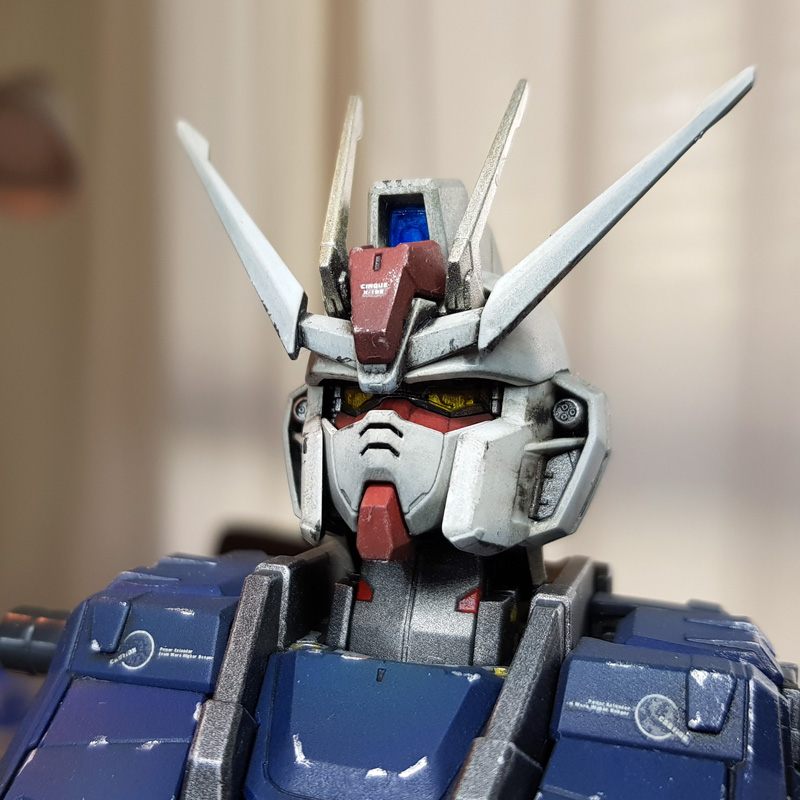
PG Strike Gundam: WIP
If you just got here and your first reaction was “I’m not reading all that”, you can also check this build out on Youtube. This blog has far more info than the video, though.
Anyway, I don’t usually write WIP blogs, but I’m not sure I’ll have anything else to post this month, this build is likely going to drag into July, and I’m really itching to talk about it a bit. I’ll have a full review and photo gallery whenever it’s actually complete, but in the meantime… here’s where I am with my PG Strike. I posted a review of the snap build almost a year ago at this point and only now just finally got around to painting the kit.
I went about this one in the same ass-backwards way as on the MG RX 78-2 3.0 where I painted the armor first and then the inner frame. This continues to make perfect sense to me because a) seeing the kit with the armor on allows me to decide which parts of the inner frame to detail paint b) if I gunk up the inner frame with weathering (or while pre-shading the head, as I did here), I can paint over it afterwards and c) I have to pry the armor off for topcoating when it’s all done anyway because I want a shiny finish on the inner frame and matte on the armor.
When the armor was all done, it looked like this. Looking at it now, I almost miss the glossy finish and I kind of wonder if I shouldn’t keep that look sometime, somehow, on a different build, if I can find an excuse.
Notice also that the stand, while very functional, is beyond ugly. I don’t know what I’m going to do about that yet, but this is unacceptable.
Also, because I did it anyway and it’s kind of fun, here’s a comparison of the four stages of painting the armor. First the unpainted picture from the earlier build review, then just pre-shaded and gunk washed, then with chipping and heat streaks, and finally with the few rust streaks I did.
I did this mostly because one of the reasons I put off painting this one for so long was that I liked it in its unpainted form. Looking at this comparison now, I don’t know what the hell I was thinking. It’s really kind of funny what a difference painting makes.
Anyway, once that was done, I decided to paint the inner frame in sections. I usually prefer to take a more assembly line approach to my builds – prime everything, base coat everything, etc. But the idea of dismantling the entire PG Strike frame and painting it all at once was… frankly soul-crushing, just thinking about it, and so I decided to break up the process a bit, mostly to keep myself motivated. It also helps navigate the build a bit, though, because you can still remember where things go if it hasn’t been a week and you’re not looking at 200 parts.
I started with the waist section, mostly so that I could mount everything on the stand as I go.
As you can see, I decided to do quite a bit of detailing on the inside of the skirts. I actually think this stuff still shows – even if you only sort of see it peeking through, your brain registers that there’s detail there and not just a big chunk of gunmetal. It was also just really fun. I’m actually seriously thinking about getting some Warhammer miniatures because I’m having so much fun brush painting the details on this kit.
And here’s the waist section all put together.
Working my way up, I did the torso next.
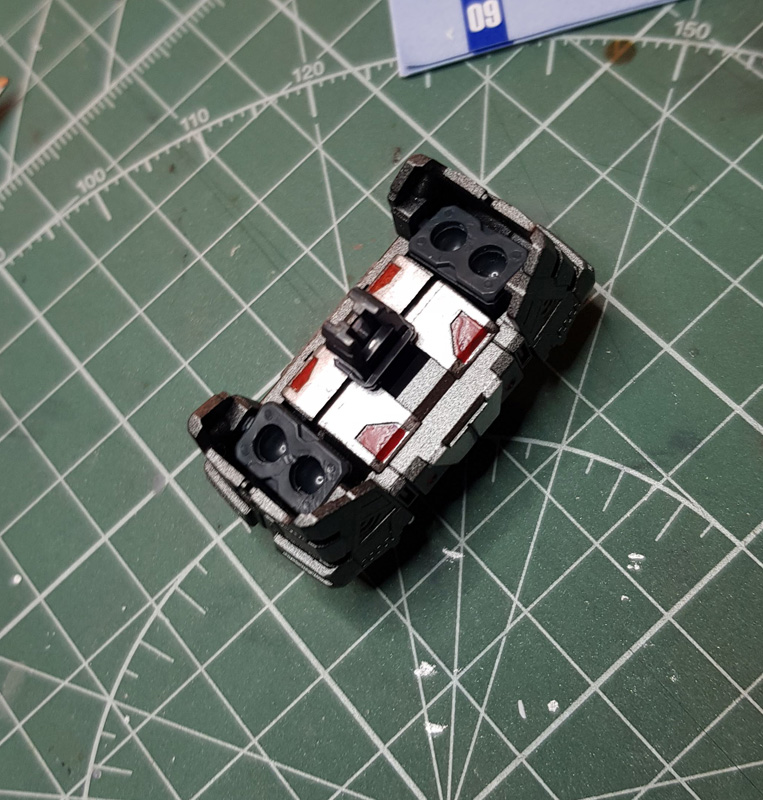
The lower half (you know, the actual waist, as opposed to the pelvis that we call the “waist unit”) gave me enough grief when I tried to put it together unpainted, and of course this didn’t get better with the paint on it. Luckily, this unsightly gap here isn’t visible once the upper torso goes on. Neither is the detail I painted around it, but oh well.
Here’s the cockpit assembly. I painted the pilot figure as best as I could given its tiny size and the fact that I couldn’t find any reference online, plus some inner detail where it’s somewhat visible from the outside.
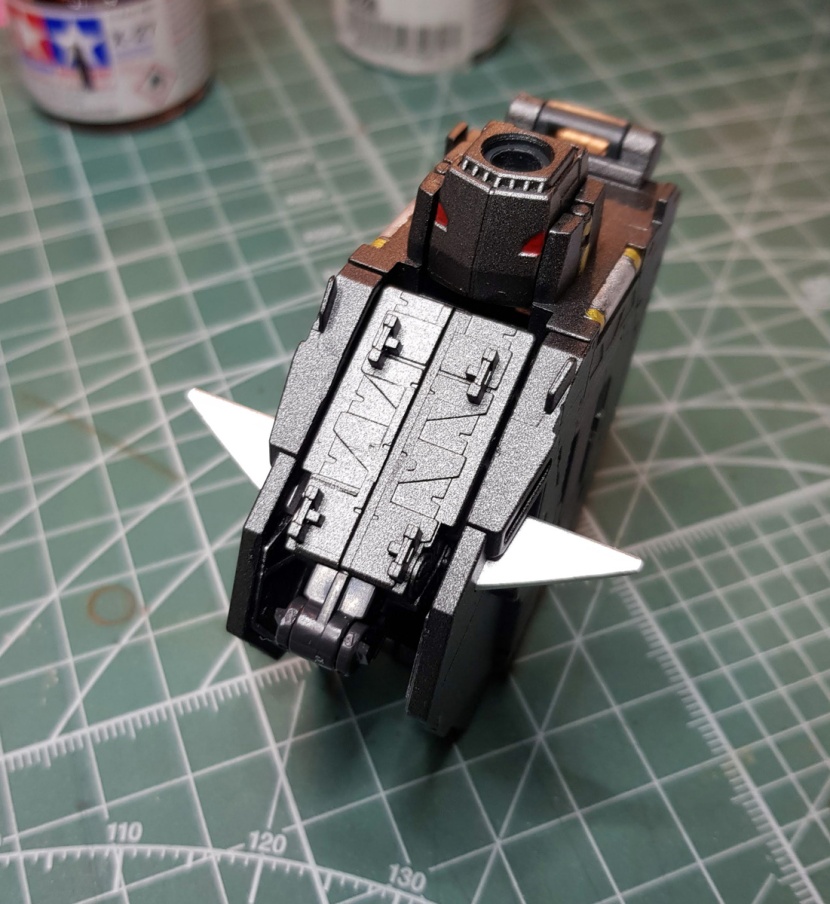
These triangular fins are the same clear piece that’s painted clear red on the inside. On the outside, I painted them chrome silver, hoping to get a silver line on the chest vents, but you can really only see them if you peek in and the light hits them just at the right angle. Same with the gold/silver pistons next to the neck here, these get completely covered up by other parts and only barely show through a tiny slit if you know where to look.
What works beautifully, though, is what I did with the collar here.
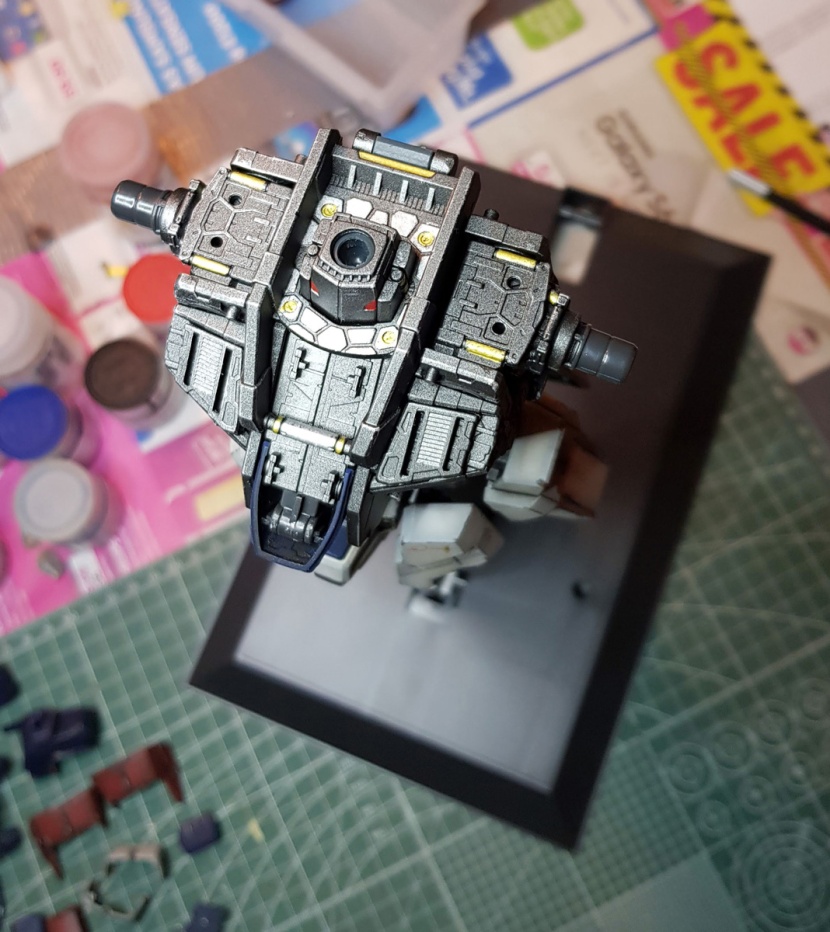
All that detail really helps make everything look more mechanical and believable on the finished assembly, and the gold pistons on the shoulders actually sort of show up as well.
And that was the torso all done. I also painted all of the pistons gold and then drybrushed them white. Oh, and the inside of the hatch on the back looks like this.
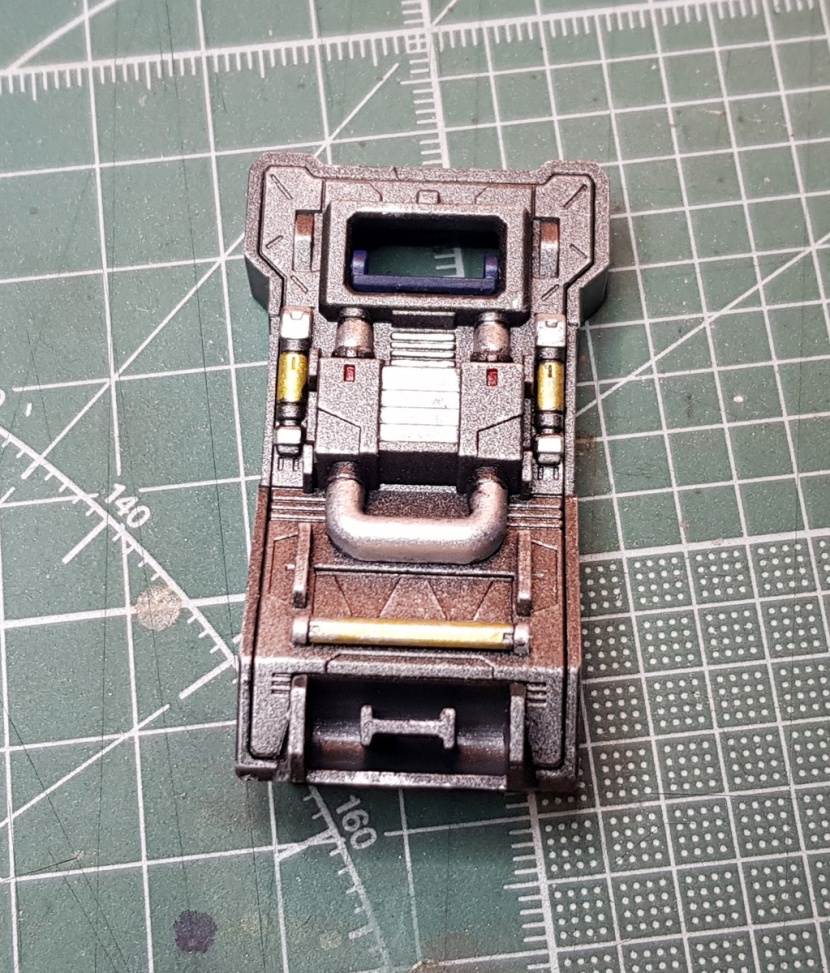
It does fold out, so this isn’t completely pointless, but once I’ve got the Aile Striker on, this’ll never be seen again.
I’ll also paint the stuff under the hatches on the shoulder armor, so at least I’ll still be able to display that if and when I want to. The sliding panels on the chest don’t work anymore now that they’re painted, but I kind of expected that and didn’t do any detail painting underneath.
I also finished the beam rifle and the shield at this point. Pretty straightforward stuff – the beam rifle is gun metal with a few hand painted details in chrome silver plus the same blue over black primer as everywhere else, the camera lens is painted clear red on the outside and chrome silver on the inside.
The shield, like the gun, is considerably more scratched up and dirty than the suit itself, but that’s very much intentional – I figure this equipment would suffer much more wear and tear and be less meticulously maintained.
One thing that bugs me here is that the titanium gold pieces (my usual replacement for Gundam yellow) were a bit too obviously not weathered along with the rest of the shield. They do have white drybrushing on them, but at the moment they look a bit too pristine for my tastes, compared to the rest. I may try to alleviate this, but the problem is that they need to be topcoated separately and they’re basically never coming off again. We’ll see.
I haven’t finished the Grand Slam sword yet, and we’ll see what happens there. Once I had painted the handle, I realized that the chrome plated blade just looked ridiculous next to the painted parts, so I want to strip the chrome, but so far I haven’t had any success. I’m not a fan of this thing anyway, so at least if I end up destroying it in the attempt, I can’t say I’ll really care too much. Painting up the blade could be fun, though.
The last thing I’ve got so far is the head. Now I complained in the build review that the pre-molded eye piece with the clear and grey parts was dumb because it couldn’t be painted, but as it turns out, I was wrong. Here’s what I did.
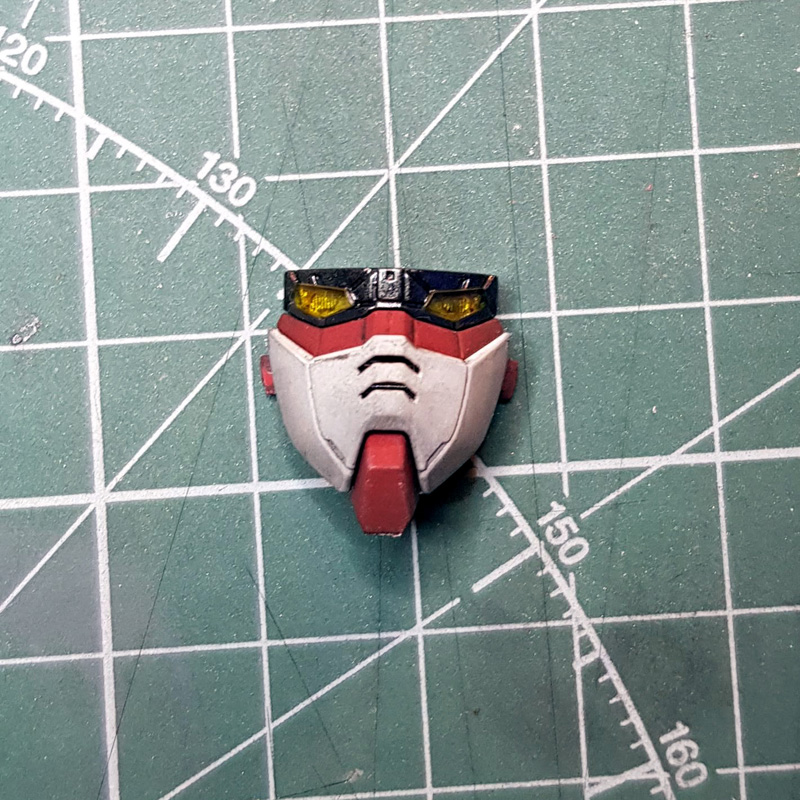
The clear parts are actually slightly raised – just a fraction of a millimeter, but enough for a small detail brush to bump up against them, so painting the area around it gun metal was a piece of cake. I also painted the whole thing gold leaf on the inside and clear yellow on the front for the clear parts, and boom, anime accurate shiny yellow eyes.
And yes, this means I won’t be able to use the LED anymore, but as I’ve said numerous times, I really think these head LEDs are pointless, especially the one on this kit because it just doesn’t work properly, and even when it does, it’s not nearly as bright as I’d like it to be. So I decided that if I was going to display this kit without the LED, I was going to paint it to look good without it, and I’m pretty happy with how it turned out.
Sadly, as per the rules of model kittening, for every small experiment that goes right, something simple that you’ve done a million times before goes wrong.
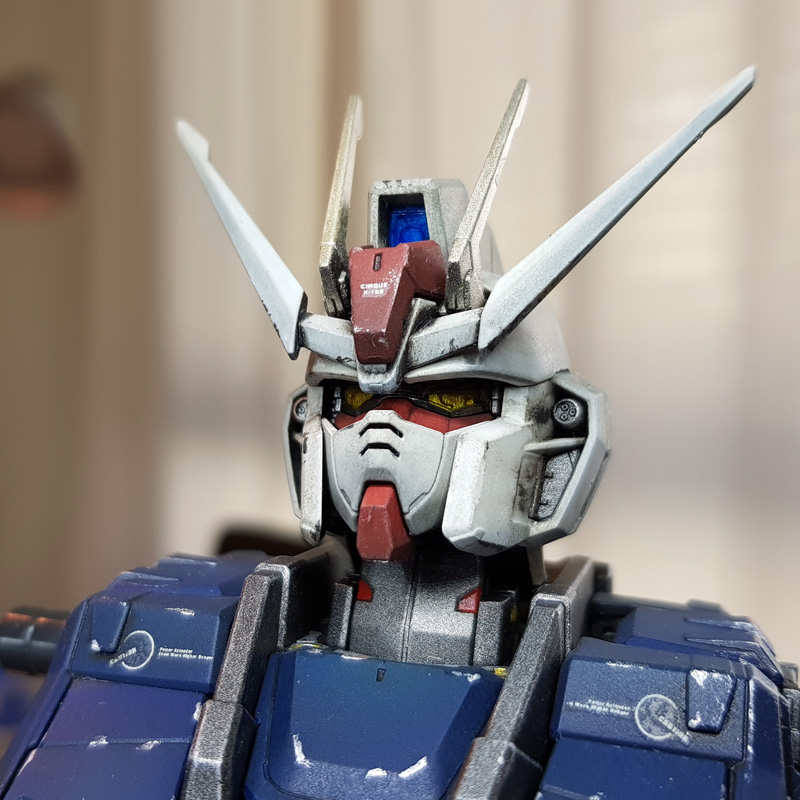
I wanted to paint the cameras silver on the inside and clear blue on the outside, and I just couldn’t for the life of me get a decent coat of blue on the big one. You can’t really see it anymore now that it’s inserted, but the paint pooled in the middle, and even after stripping and reapplying it did the same thing again, so I gave up. Sigh.
Otherwise, the head was a pretty straightforward affair. Since all the mechanical detail gets covered up, I just drybrushed it chrome silver over the gun metal and left well enough alone.
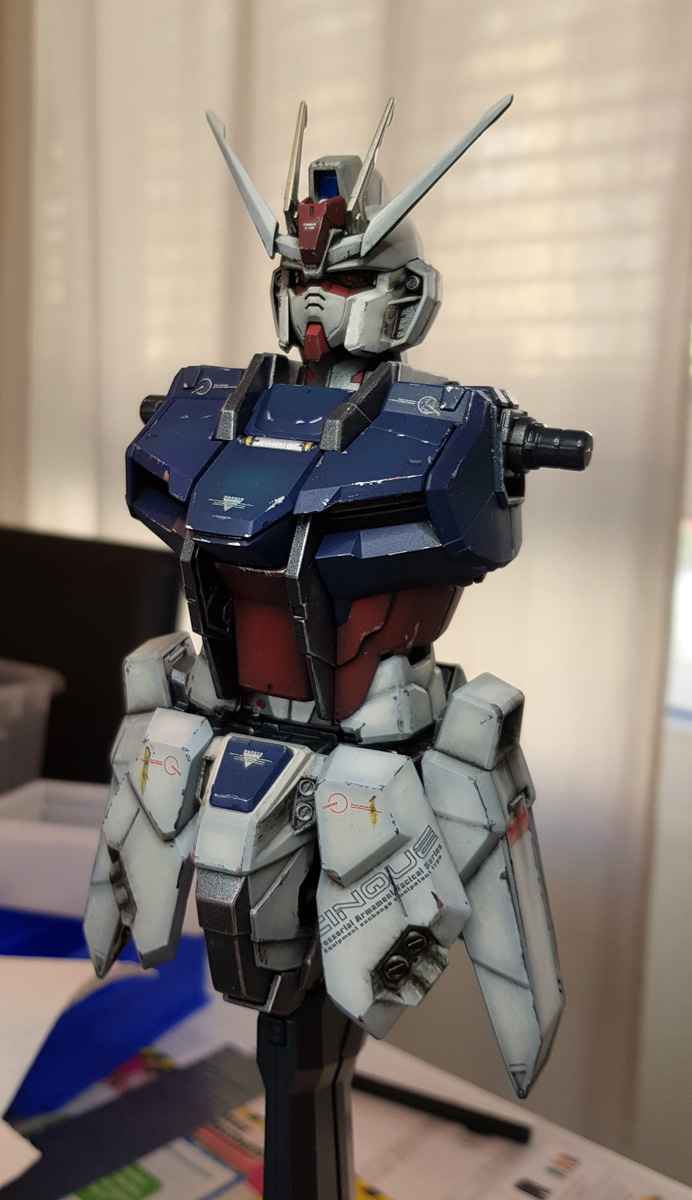
And that’s it for this WIP update. As I’m writing this, I’m getting started on the limbs, which will no doubt take a good bit longer than the torso what with how complicated the legs are. I kind of want to be done with the suit before the 21st because that’s when I’m going away for work until the end of the month, but we’ll see. I’ve been at it for months, so no point in rushing things now.
Not to mention I haven’t even primed the parts for the Aile Striker. Ideally I’d have that painted and gunk washed by the 21st so the oil paint can dry while I’m gone. And then there’s the base. I don’t even have a plan for that yet, all I know is I’m not leaving it unpainted.
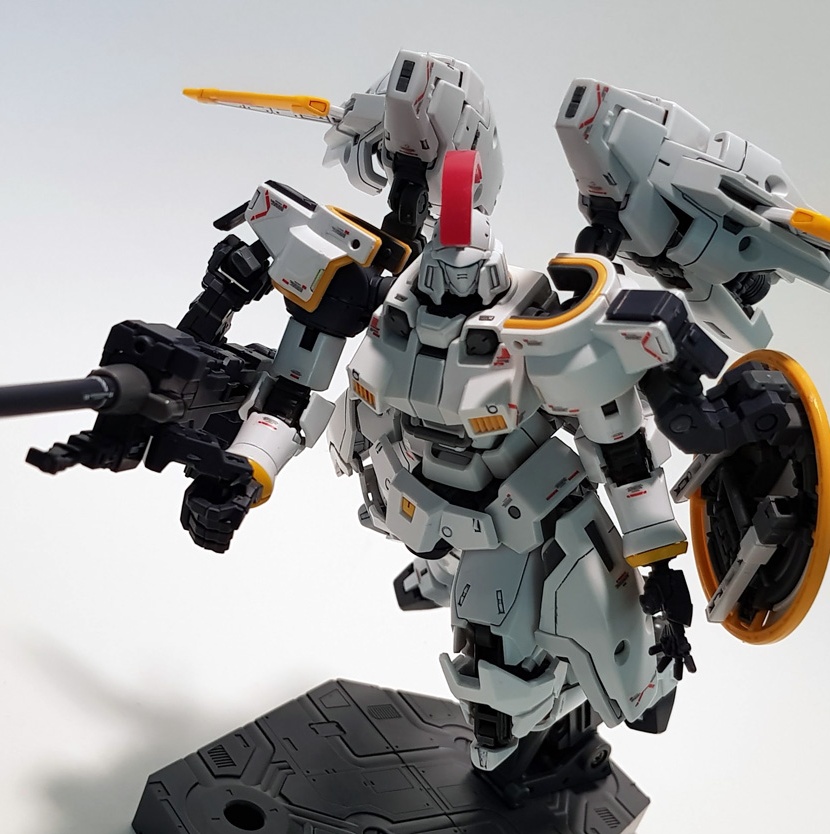
Real Grade Tallgeese EW
You never forget your first.
I’m probably the only western Gunpla blogger alive or dead who didn’t grow up on a steady diet of Gundam Wing, and that, if you’ve been wondering, is the reason why you don’t really see any Wing kits on this blog. The Tallgeese, though, has kind of a special place in my heart.
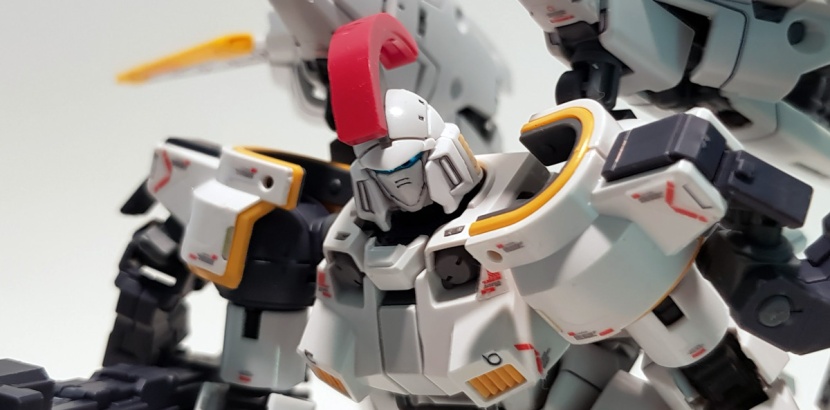
See, way back around the turn of the century, I was really exclusively into Tomy Zoids and wanted to do a bit of kitbashing. Word around the Zoids community at the time was that “Gundams” made for good parts fodder, so I bought a few. The first of them was the 1/144 Tallgeese (this No Grade version, if memory serves), and while I did raid it for parts, I also built it first because I was curious about the kit. And honestly, taking it apart to slap the boosters on a Redler and use the shoulder joint to mount a cannon on kind of hurt. I really liked the design, and it was hard not to notice the quality of the kit, even back then.
Years later, I still sometimes thought of the Tallgeese and kind of meant to replace it. I’ve had the MG version sitting in my closet for a while now, but I’ve always been a bit apprehensive about whether I’d be able to do it justice. It’s white and it needs pre-shading, but all those curvy armor pieces look like they’re going to be a bitch and a half to shade.
Needless to say, when the RG was announced, I got my preorder in faster than a fat guy orders his supersize meal at Mickey Dee’s. Finally a quick fix for the glaring absence of a Tallgeese in my Gundam collection, and it’s the right version, to boot.
So here’s what’s in the box.
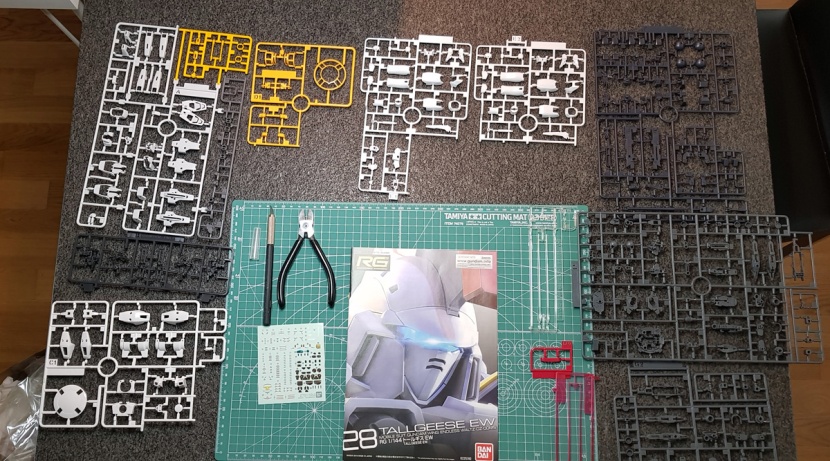
For some reason, the kit includes two clear beam saber effect parts along with the usual red ones. Sadly, the camera for the Dober Gun is also molded completely clear. There’s a blue sticker for this, but I decided to paint it clear red instead because clear blue always comes out too dark. Turns out the red did too. Oh well.
The sticker sheet is fairly small, which shouldn’t be too surprising – they opted to keep the general slick look of the Tallgeese and not clutter it up RG style with too much surface detail, and so there also aren’t that many stickers.
The white plarts are molded in a similar glossy plastic to the Sinanju and also pretty much all undergated; I don’t think there’s a single visible nub mark on any of the armor.
The big thing to notice here, though, is the small size of the B sprue. The internal frame on this kit is almost completely assembled the old-fashioned way with only a small handful of the usual pre-molded joints.
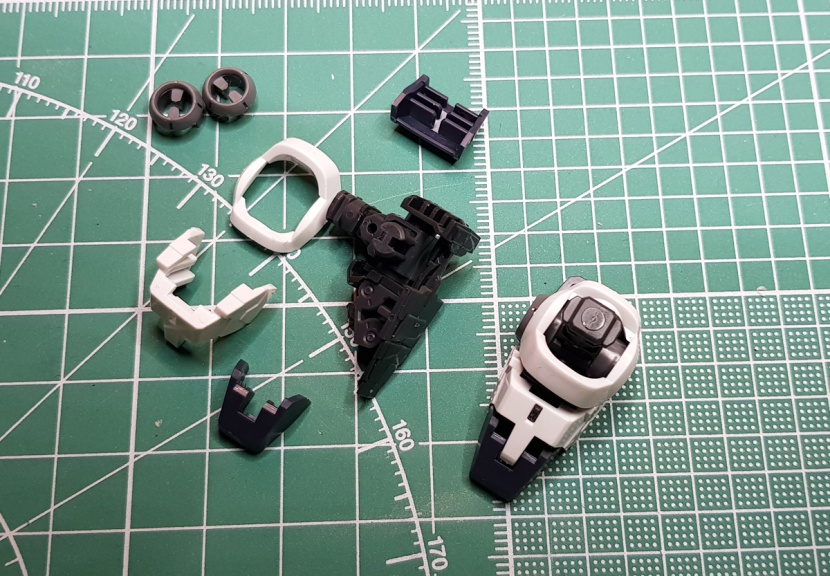
Nothing out of the ordinary about how the build starts, though – it’s with the feet. You take the internal frame part for them (which is really chunky in this case) from the B sprue and slap the armor on it.
What follows is unusual, though. Here’s the inner frame for the legs.
Only the part in the top left of the first picture comes from the B sprue, the rest is just regular grey plastic. You then assemble the knee joint with the mechanism for the armor separation much like you would on an MG.
Then you add the armor and you’re done. Nothing fancy here, although of course the ball-shaped joint for the hip also doesn’t come pre-molded.
An amusing idiosyncrasy is how the bottom of the armor goes on – at first I thought this was the ankle armor and just sat loosely on the foot, but you actually click it into place after assembling the rest of the leg like so:
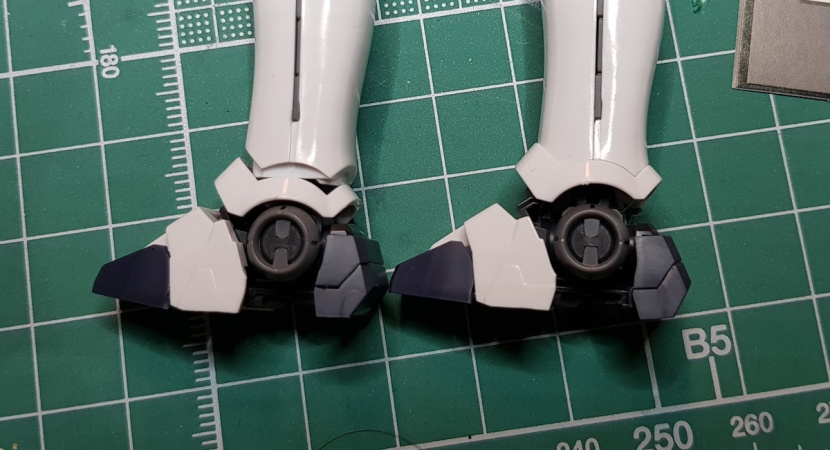
The waist unit is a rather massive undertaking, of course, because all the skirts have to open. It also doesn’t have a B sprue part, you actually start by sandwiching its halves together with the moving parts in between.
The extending crotch thruster gimmick will never not be weird. How many more kits with alien genitals are we going to get, Bandai? Wasn’t the Nightingale enough?
The rear and side skirts are next; the rear skirt section is one piece, but it still consists of a number of parts because it has two separate hatches that open to reveal thrusters, and the side skirts are actually double jointed.
Speaking of the side skirts, they also have this little connecting rod that plugs into a hole on the side of the thigh to help them move along with the legs. This works very poorly, though, as the rod keeps unplugging from the leg. And frankly, if it didn’t, you’d probably snap it in half within five minutes. So it’s all really kind of pointless.
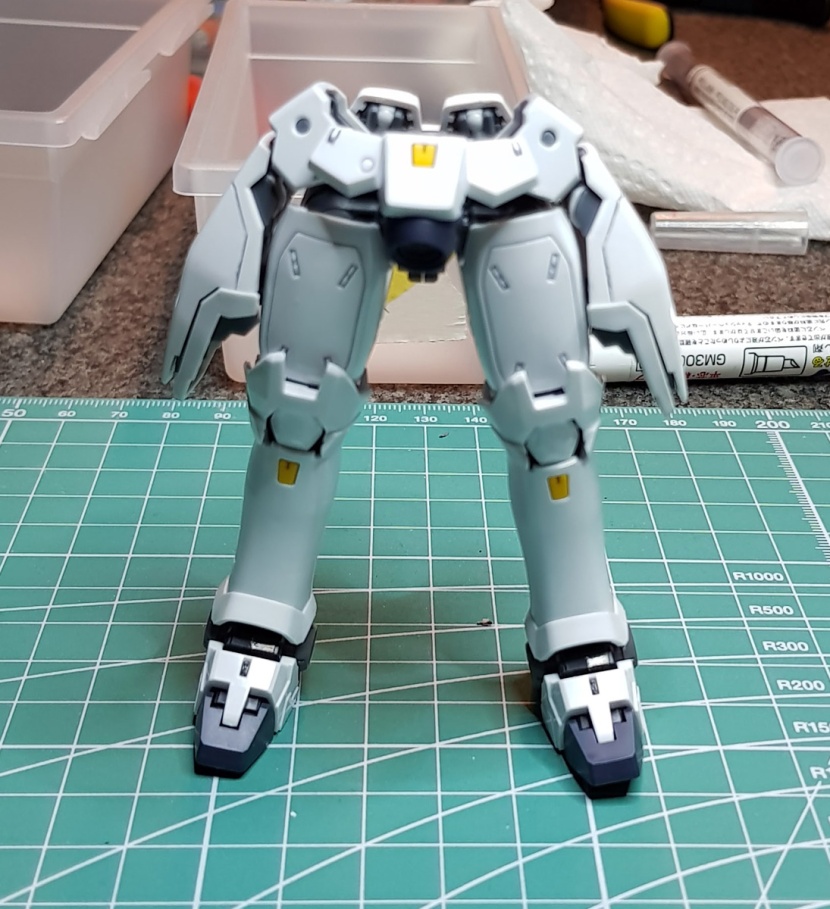
Yep, starting to look like the Tallgeese alright. Next is the torso. You’d think this section would be simple as it’s so tiny because Katoki proportions, but you’d be wrong.
As there’s no B sprue part for the torso either, it all has to be assembled; the advantage of this is that the white part for the cockpit hatch can simply be attached between the two torso halves.
The arms have the only B sprue part that really looks like your standard RG inner frame. In another amusing bit of Tallgeese assembly weirdness, though, the orange yellow trim part for the wrist doesn’t just click on, but you put it on and then rotate it 90 degrees to lock it into place. Same with the entire shoulder armor assembly. Be careful not to get the B parts for the arms mixed up – they look almost identical, but they’re not, and if you rotate the shoulder armor the wrong way to lock it, you end up causing damage. How do I know this? Oh, just something I heard.
Another oddity about this assembly is that you do not, in fact, attach the arms next, but build the head, in two parts.
The instructions specifically tell you to first attach the bottom part of the head to the neck, then the dome/face combo. I have no idea why. Or why the instructions are done in a way that forces me to break with my Headless Hessian tradition. Anyway, it’s a nice looking head, but they really could have added some detail to the crest/fin/whatever. This thing looks beyond weird for a RG.
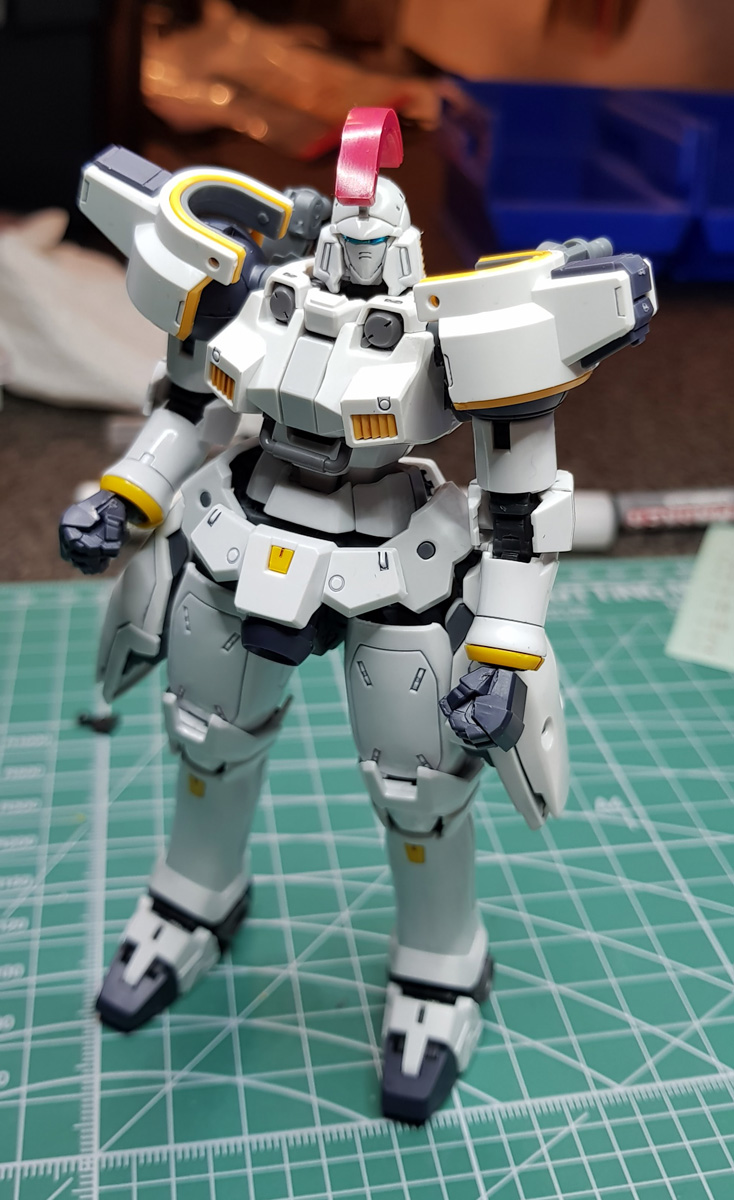
And here we are sans boosters. Needless to say, their assembly is pretty involved. Everything has to open and close, so the boosters are broken down into several interlocking sections.
In all honesty, I’m not terribly impressed with the engineering here. These things certainly look nice, but there’s a moving lever part in the middle (just under the armor piece with the yellow bit) that does basically nothing, and everything else has to be pried open and moved into place manually without any kind of mechanism making it slide into place on its own.
But anyway, here’s a shot of the suit with and without its accessories before I put the stickers on. As you can see, it stands up just fine, which comes as a pretty big surprise.
The accessories are about what you’d expect, except for the hand options. You get a pilot figure, the aforementioned four beam saber effect parts and two handles, the Dober Gun and the shield, plus no less than seven hands. Two fists, two open ones, two holding hands for the beam sabers and the handle on the shield, and one trigger finger hand for the gun. Also, the beam saber handles can be stored inside the shield.
The holding hands have angled wrist joints and also hold the sabers at a forward angle; this works really well for posing, as you can see here. The suit can hold the sabers at a much more natural angle than the awkward 90 degree TF G1 toy pose that you tended to get with the older RGs. No poseable hands, by the way, and thank god for that.
What doesn’t work as well, sadly, is the Dober Gun. The big contraption that attaches it to the shoulder armor works fine and can hold it up on its own, but it’s pretty ugly. Also, if you want to have the suit actually holding the handle as in the last picture here, you’re pretty much stuck with one pose for the arm – it’s a pain to wiggle it around until it all goes together, and there’s pretty much only one way to do it.
Poseability is pretty good considering all that’s going on with the kit. The torso has a considerable amount of ab flexibility and the head can also be tilted backwards so you can get some decent forward flying poses out of the kit. It’s also really, really solid – I don’t think a single piece fell off while I was working with the kit for these pictures.
And of course it looks great. I was a little apprehensive about the design choices here when I saw the preview pictures – obviously the designers struggled with the fact that the Tallgeese’s look doesn’t really lend itself to an RG kit. It’s meant to have a lot of large, clean surfaces and too much clutter wouldn’t have made it look meaner or more interesting, just weird. I think ultimately they struck a really good balance here where the kit looks detailed, but also retains the character of the original design.
I’d definitely recommend this kit if you’re a fan of the Tallgeese. If you’re not, though, I’m not sure there’s any urgent reason to get this. It does everything it needs to do, it works, it’s sturdy, and it’s also a really fun and smooth build without too much frustration or fiddliness, but on the other hand, there’s just nothing all that special about it, other than maybe the near total absence of the usual RG inner frame parts. It’s just a good, solid RG kit of a classic suit that won’t disappoint you if you like said suit, but if you don’t, it also won’t change your mind.
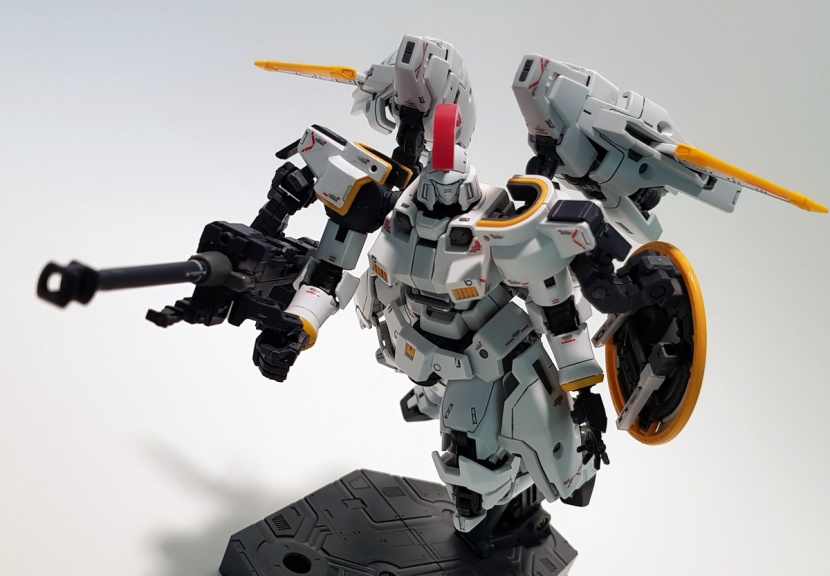
Real Grade Gundam Exia Build Review
Yeah, I thought I was going to get some photoshoots done this month, but guess what… I didn’t. So what I’ve got, and you know I have to get this one here so my archive isn’t missing a month, is a build review of the RG Exia that I snapped together a few weeks ago. No pose pictures, or at least not yet – you might remember I did the same thing with the RG Unicorn… and also haven’t gotten around to the photoshoot yet.
Anyway, the original plan was for this to be the first time I use waterslides on an RG, but once I started prepping the parts, it became pretty obvious that that wasn’t going to happen. The RG Exia isn’t super complex or anything, but it does have a ton of clear parts with foil stickers under them and these clear sheet strips for the GN power lines, which really makes it impossible to just assemble the limbs and then topcoat them. And frankly, I just still can’t deal with the idea of painting RG parts individually, even if it’s just for a topcoat over waterslides. So I just did my usual thing here, panel lined everything on the sprues, then cut the parts loose and got to building.
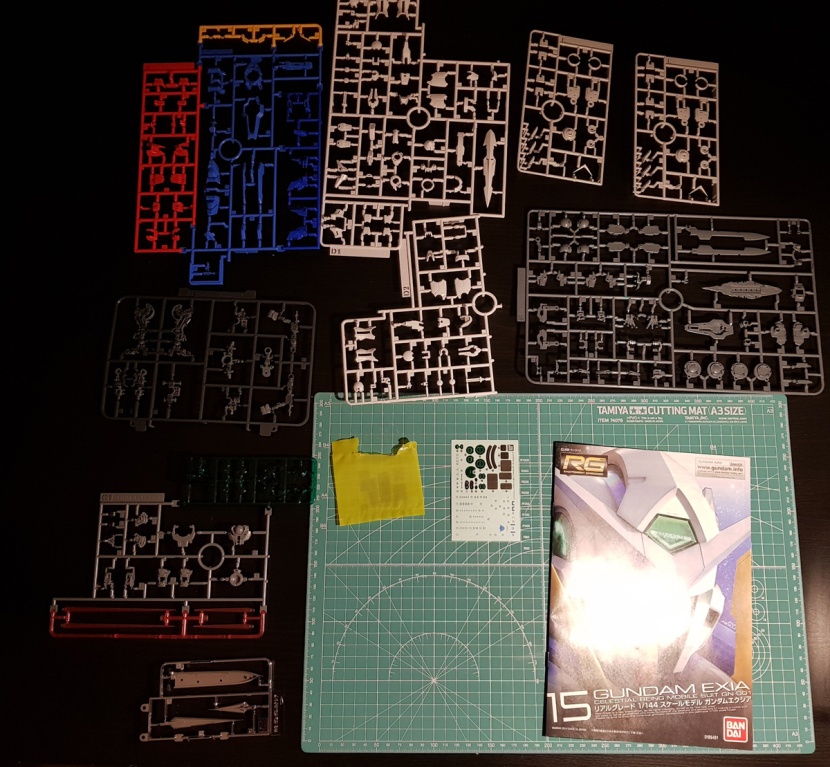
Behold the worst box contents shot in the history of RoboShop. Sorry about that, folks, but obviously by the time I noticed that this picture sucks, I kinda couldn’t put the toothpaste back in the tube anymore.
Anyway, nothing too unusual going on here, with two exceptions – there’s a chrome plated sprue for the blades, and inside that little yellow bag is the sheet with the GN power line parts. More on that later.
The build starts with the legs, which, funnily enough, are actually not one piece on the B sprue. As you can see here, the foot comes attached to the lower half, but you actually put together the double-jointed knee from two other parts. It all works just fine and dandy, it’s just odd for a Real Grade, I guess.
The GN power lines are this weird iridescent sheet plastic. To be honest, it doesn’t look that great. In some places, like on the upper thigh, they have a foil sticker under them, but it really just ends up looking like you glued a piece of tinfoil to the kit. I guess this is just an aspect of the Exia’s design that’s difficult to pull off. You know, unless you want to pay three figures for the PG with the LEDs. I hear it looks pretty neat on that one.
The rest of the leg assembly is pretty straightforward. As you’d expect on an RG, there’s a fair number of moving parts, the foot articulation actually works for once, and the green foil sticker with the graphic printed on it actually looks really nice under the clear piece.
The torso is where the Exia’s commitment to the circle as a design element is the most extreme, and I have to admit, I got quite enamored with it when I was putting this section together. The armor pieces layer on top of each other in a way that really creates depth and detail, and there’s a real sense of functionality here where you get the feeling that this part powers the suit. Even though, you know, none of it makes any sense. It just looks convincing if you can suspend your disbelief long enough to believe in teenage boys that can control giant robots with space magic.
The GN drive, of course, plugs into the back. It’s very nicely detailed and has these three clamps that close to… well, look like they hold it. It actually clicks into place securely without them and then won’t really come off anymore, but it looks pretty cool.
The waist section isn’t built separately but attached directly to the torso as you assemble it. No side skirts, just front and back, and I’m happy to report they’re all two pieces each. This shit matters, folks. The beam saber handles, uh… plug into the Exia’s ass cheeks, I guess. Moving along…
Nothing unusual going on with the arms. There’s another clear piece with a sticker underneath, otherwise they’re very simple and don’t do much. I made a really bad mistake here, though.
See, the long GN power line that goes from the shoulder armor to the upper arm is meant to hook on to this peg on the side, and then you secure it with a small armor piece. This works perfectly, but the problem here was that there’s a friggin’ nub mark right on top of that peg, and so I more or less cut it off completely on the other arm. I did leave just enough there so it held the GN power line in place well enough to glue everything together, so it looks fine now, but… well, don’t cut off this peg, folks.
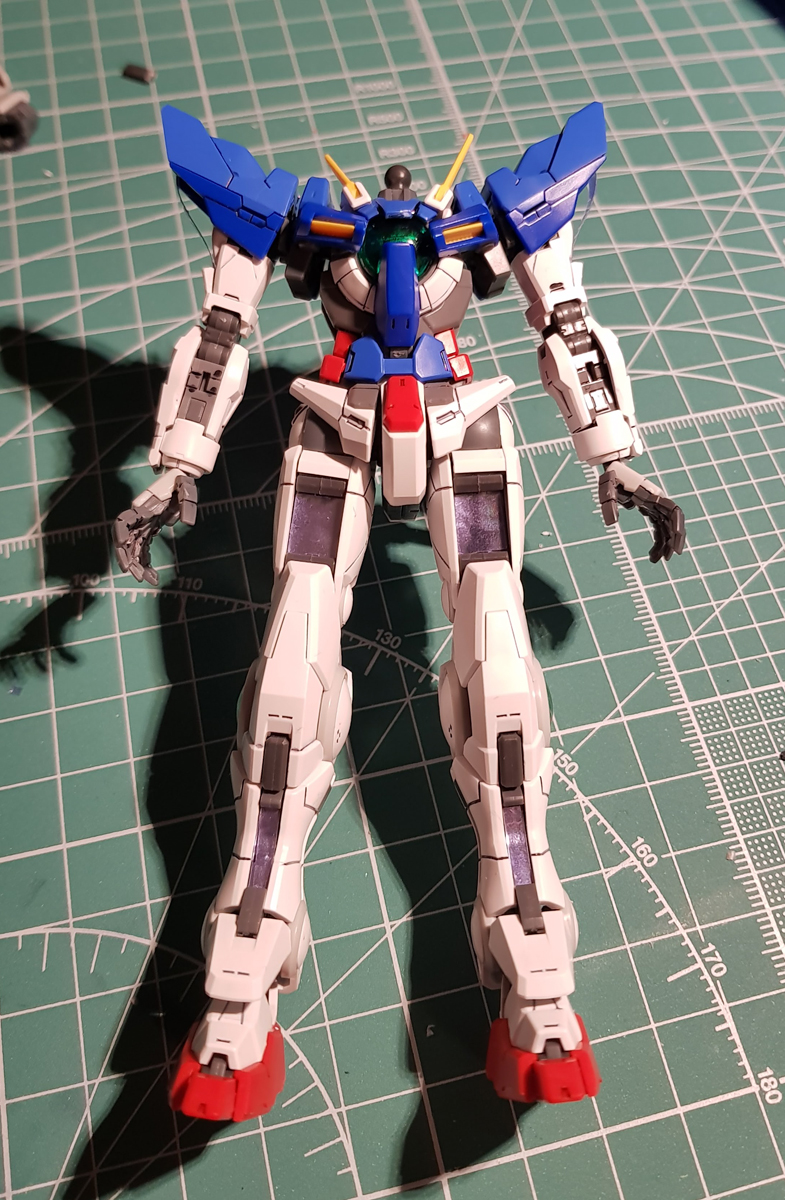
I don’t know why I keep taking the Headless Hessian pic, but here it is. I think it was at this point that I realized the fixed-pose open hands are laughably out of proportion with the rest of the kit. Notice also that I forgot to clean up some of the panel lines on the right arm. Oops.
The head is… urrk. Sure, it looks nice, but this may well have been the most difficult Real Grade head I’ve ever assembled. Those little yellow vent pieces fell out at least half a dozen times before I got them in place, and while you’re trying to prevent that from happening, you’re pressing down on a GN power line piece with one finger, trying to tuck it into the armor part that goes on top of it. And also, these weird little ear pieces have an absolutely massive nub mark on them. Which is actually kind of a running theme for this kit. It’s really well engineered and super solid, especially for an RG, but man, does it have some big, fat nub marks in really conspicuous places.
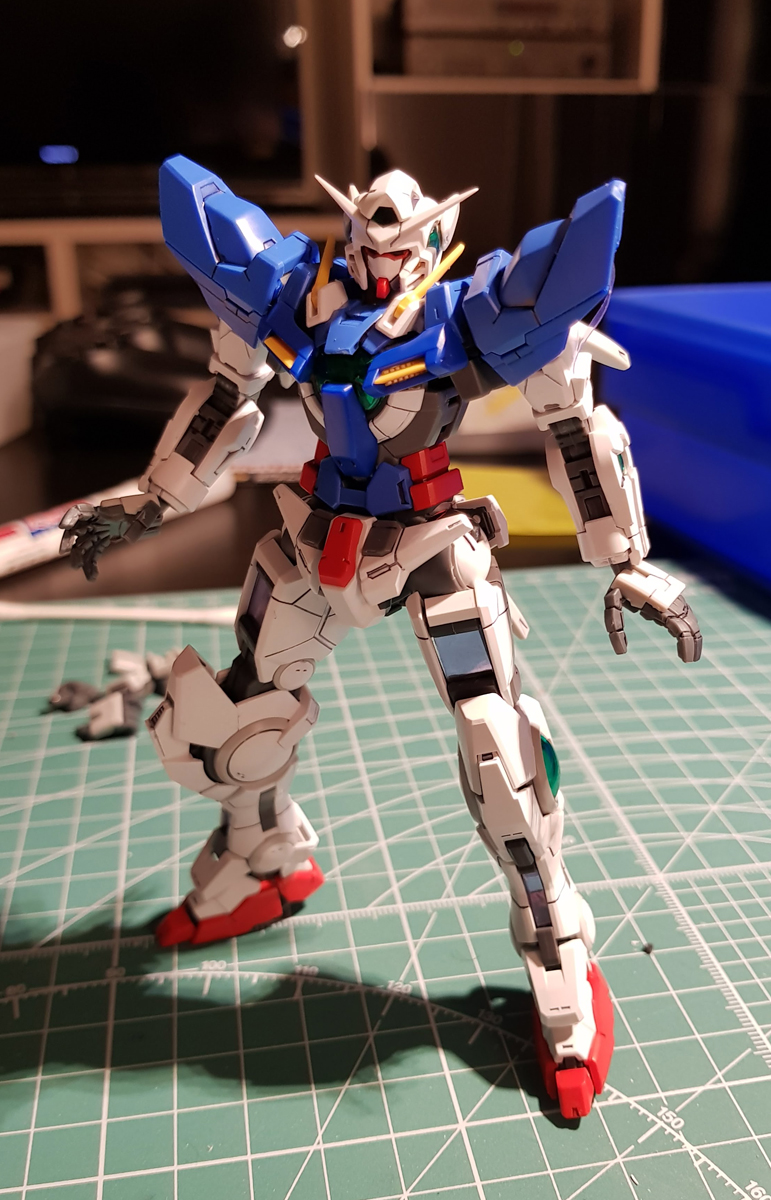
Anyway, head goes on, suit looks like zis, ja. I tried to do a pose with the open hands, but as you can see, it didn’t work out too well. I trust I’ve said enough times that I’ll always prefer fixed-pose hands like these, and I usually really like open “emote” hands for posing, but the way these bend at the wrist really make them useless, plus, like I said further up, they’re way too big for the kit.
And that’s it for this one, folks. I’ll have to post a second blog for at least the accessories and some pose shots, obviously, because the GN Sword’s kind of a big deal.
In the meantime, do I recommend this kit? If you like the Exia, yeah, absolutely. It’s designed with a lot of attention to detail, it poses well, and it’s one of the RGs that don’t explode when you touch them.


































































































































































































































































































































































































